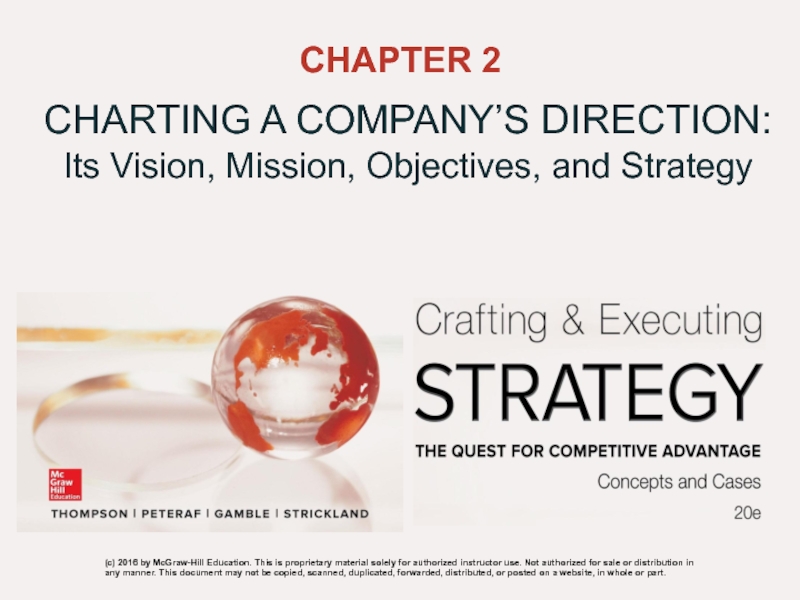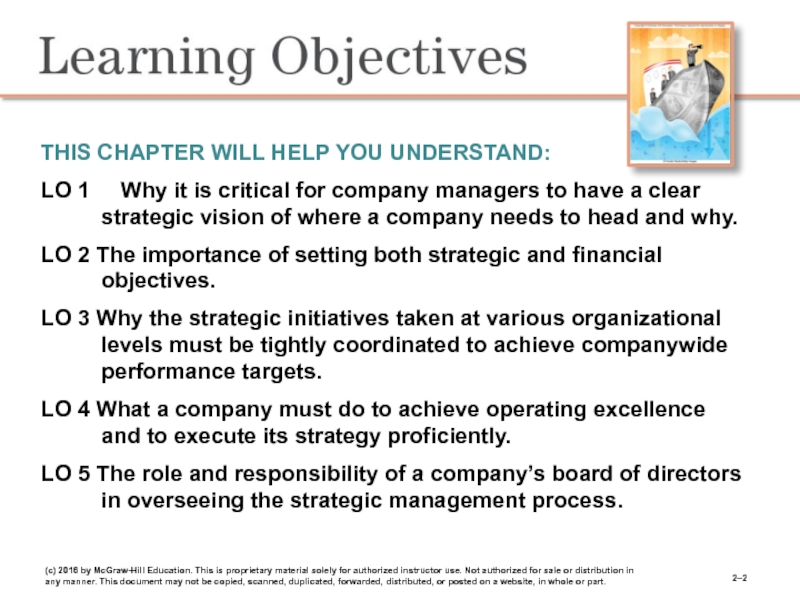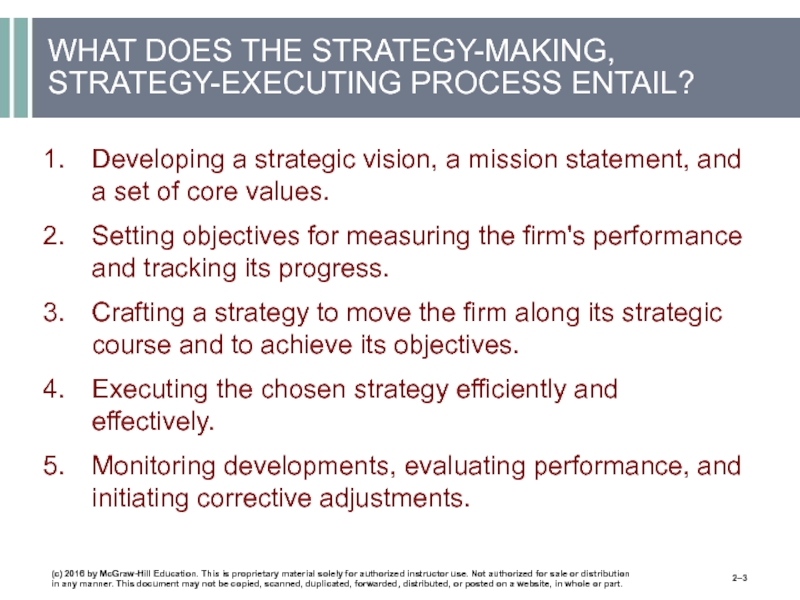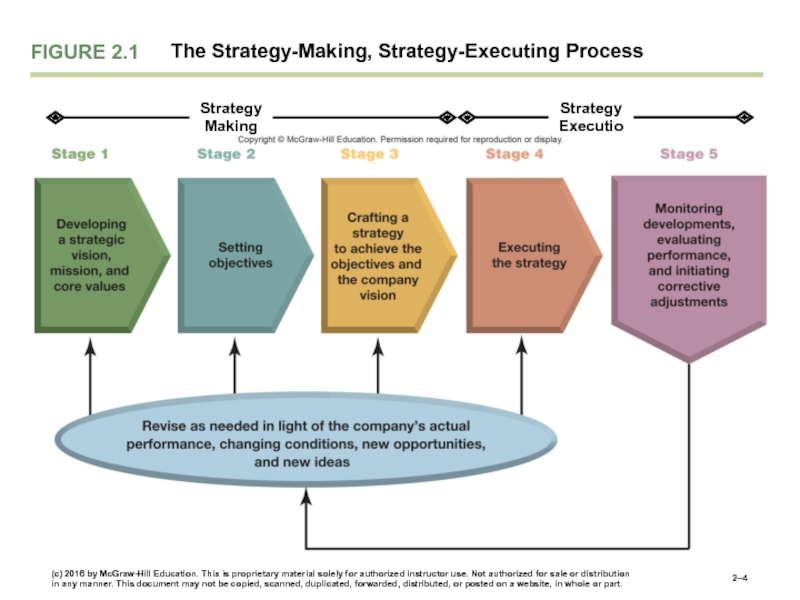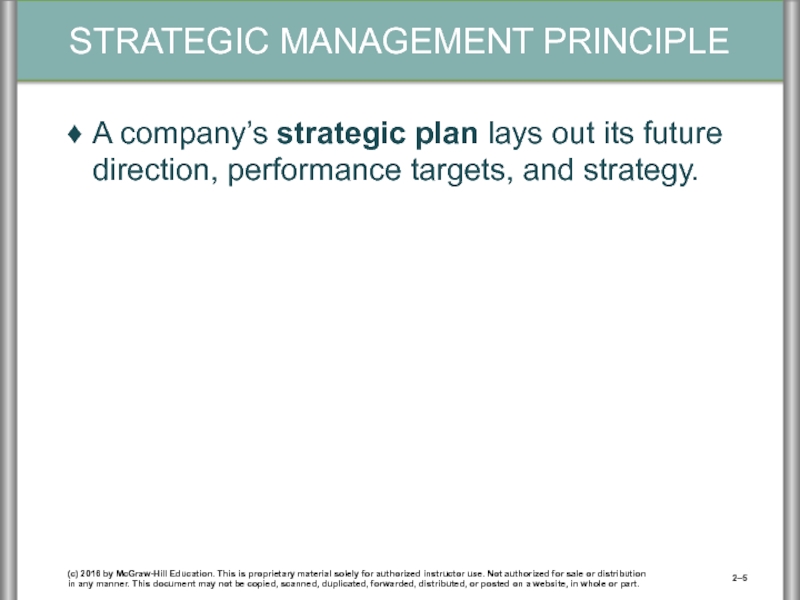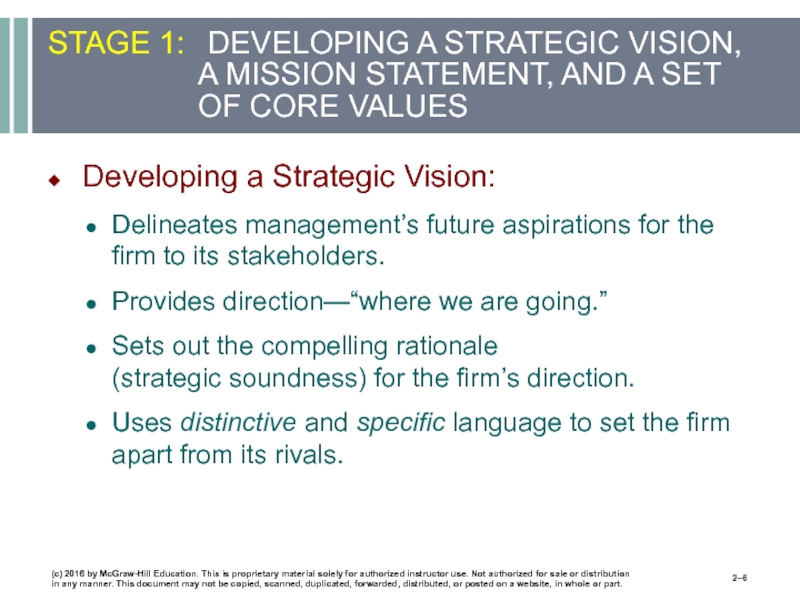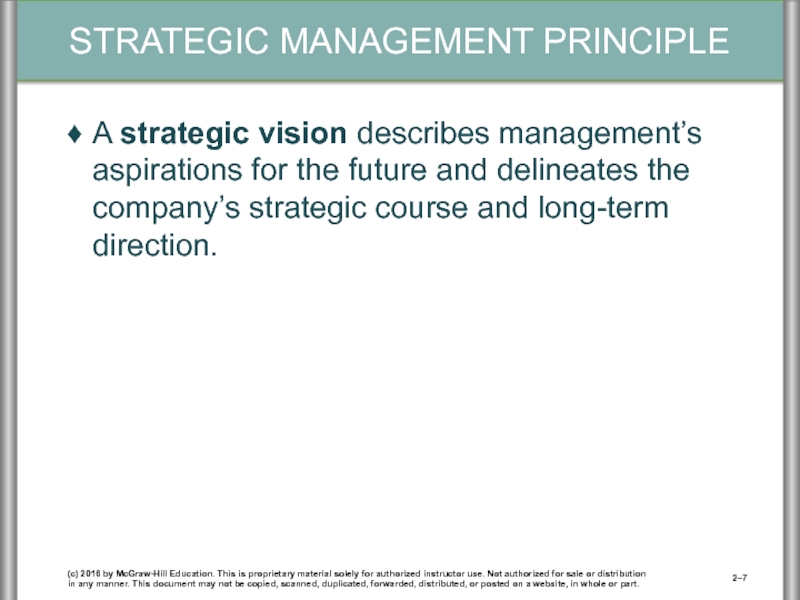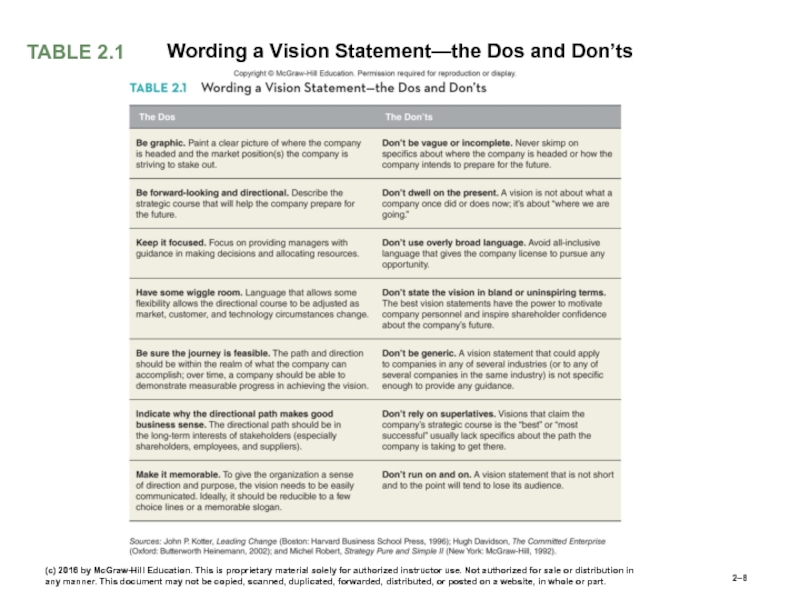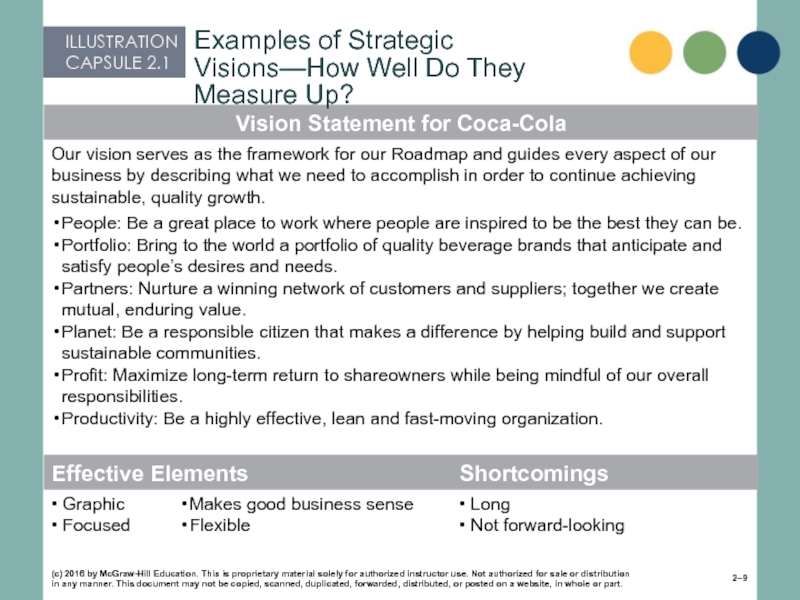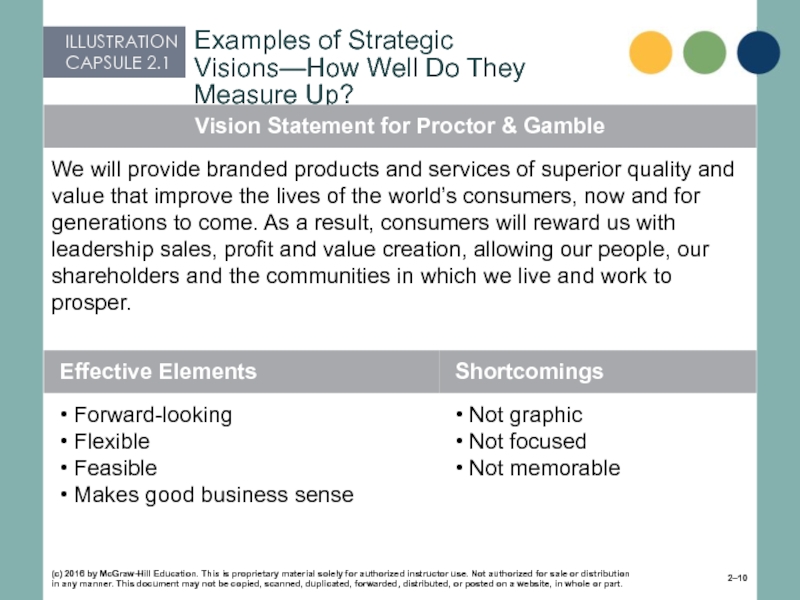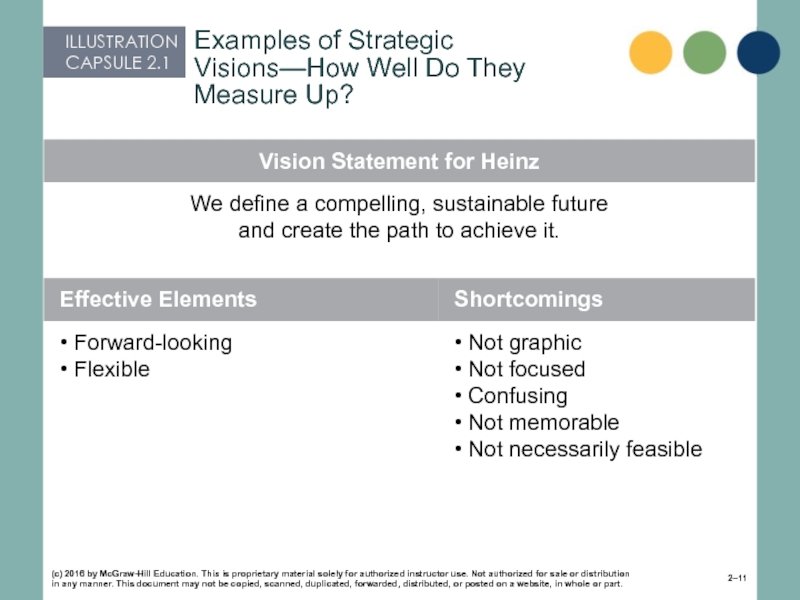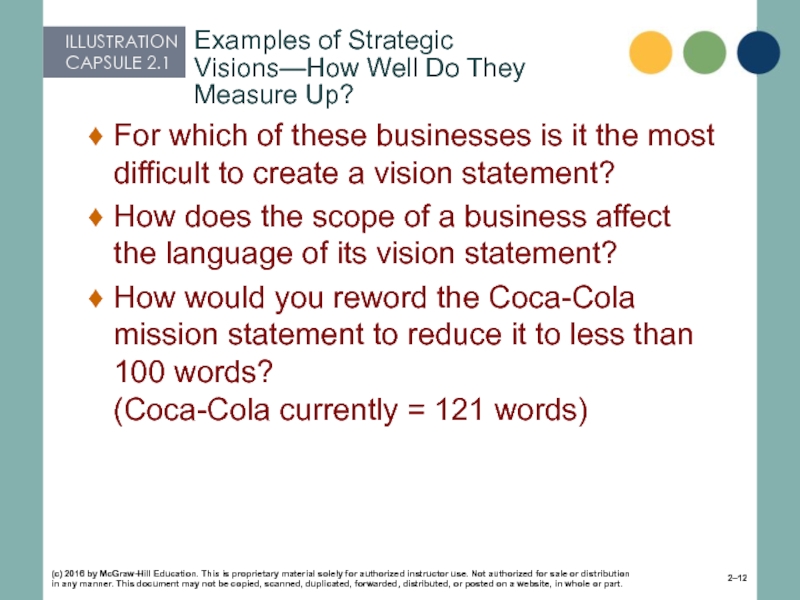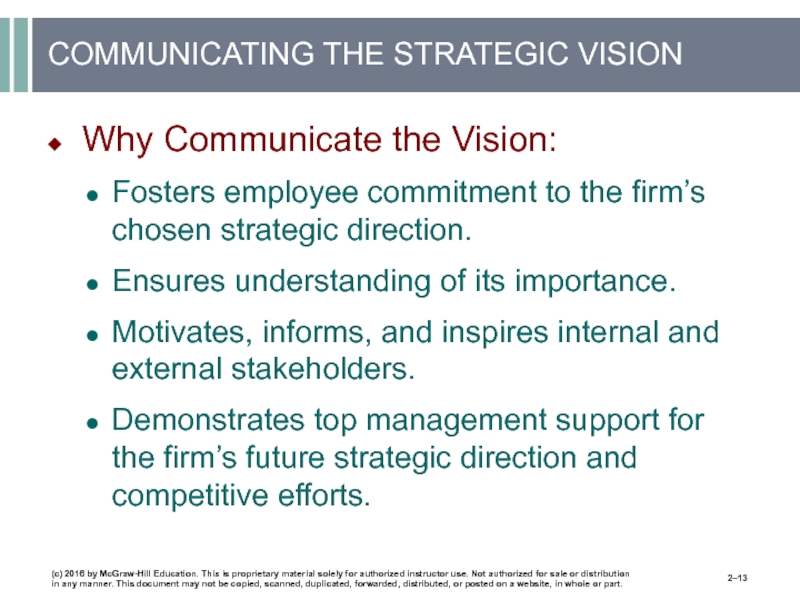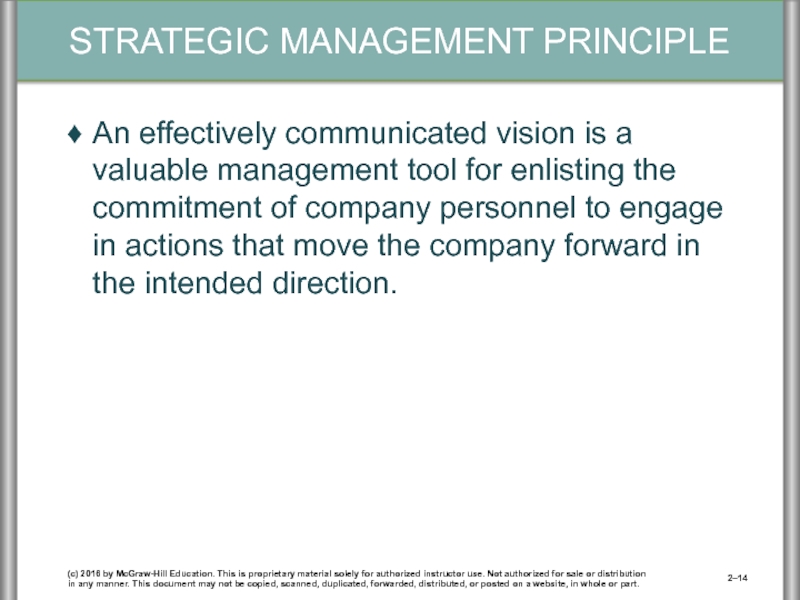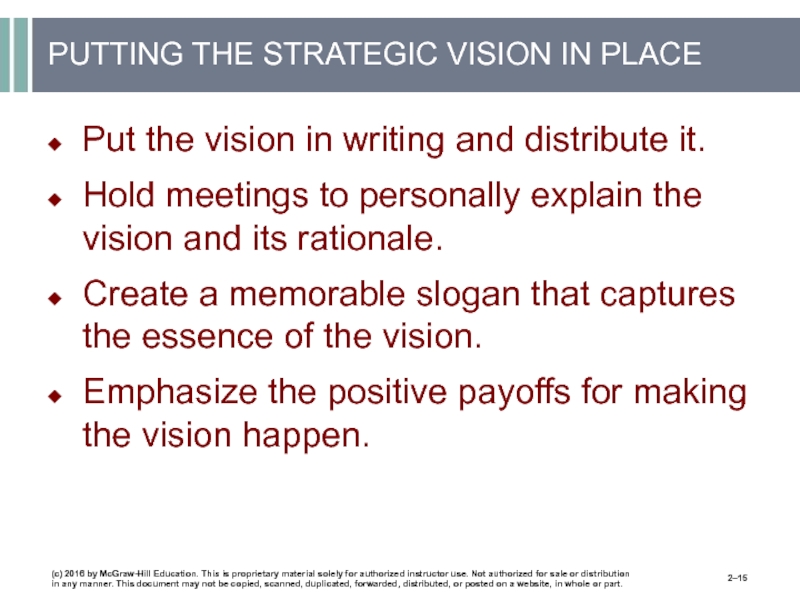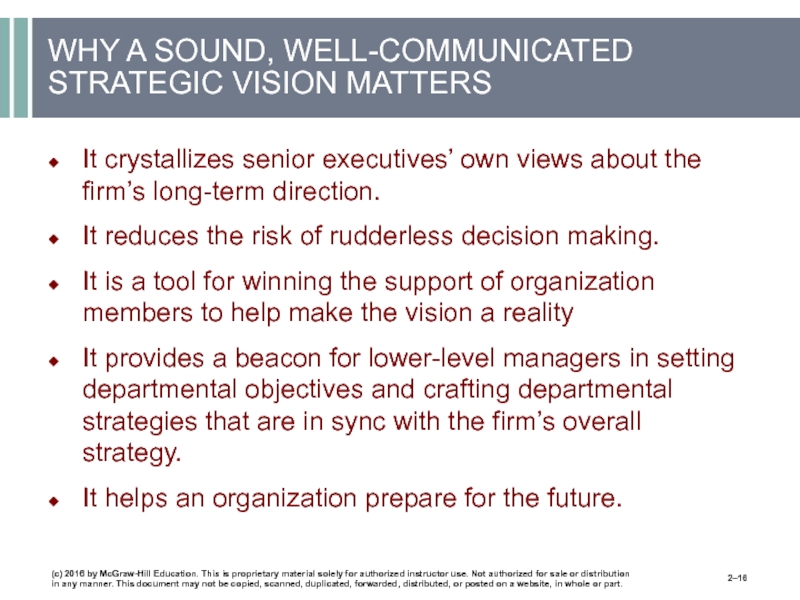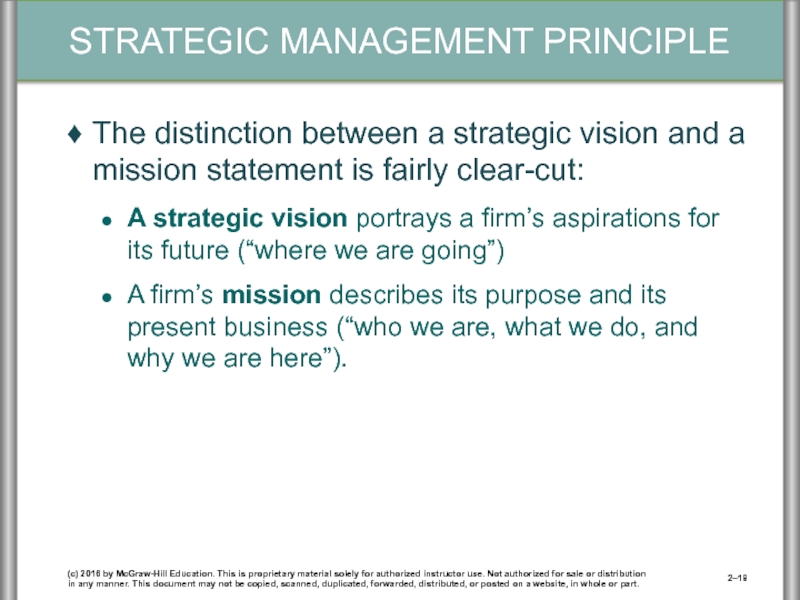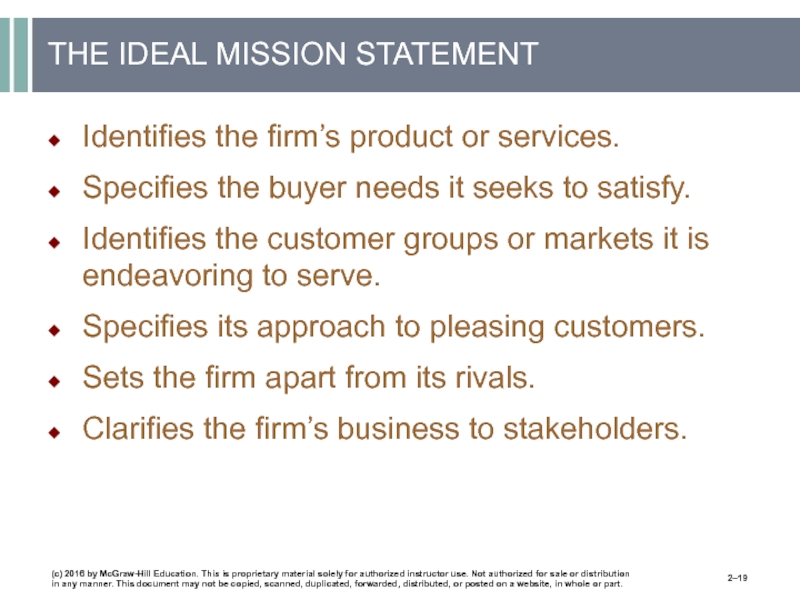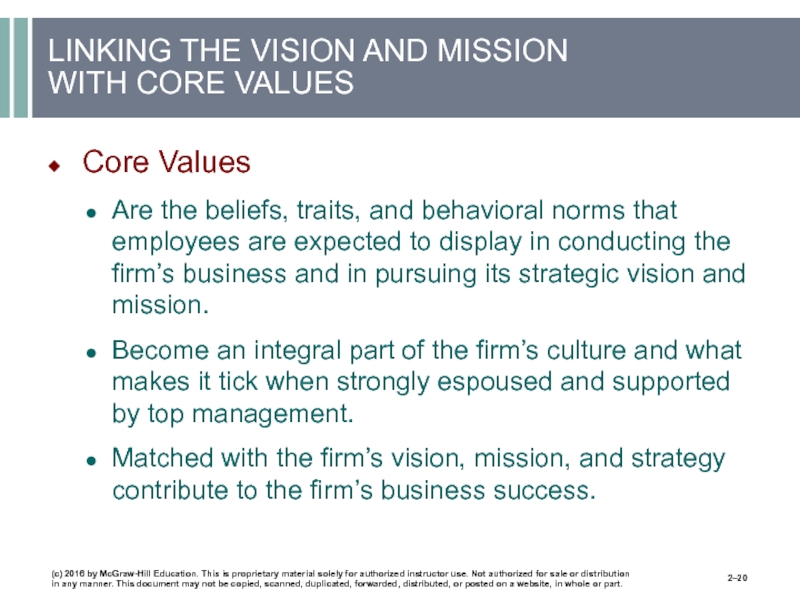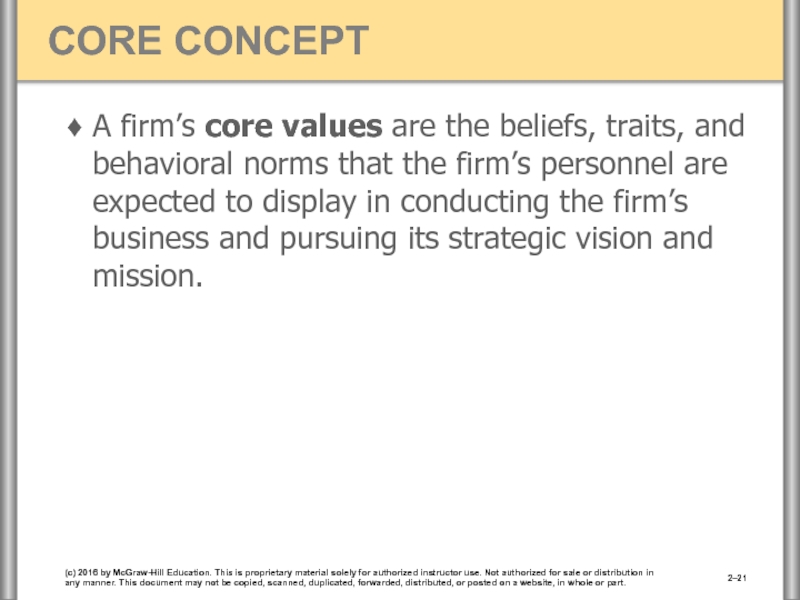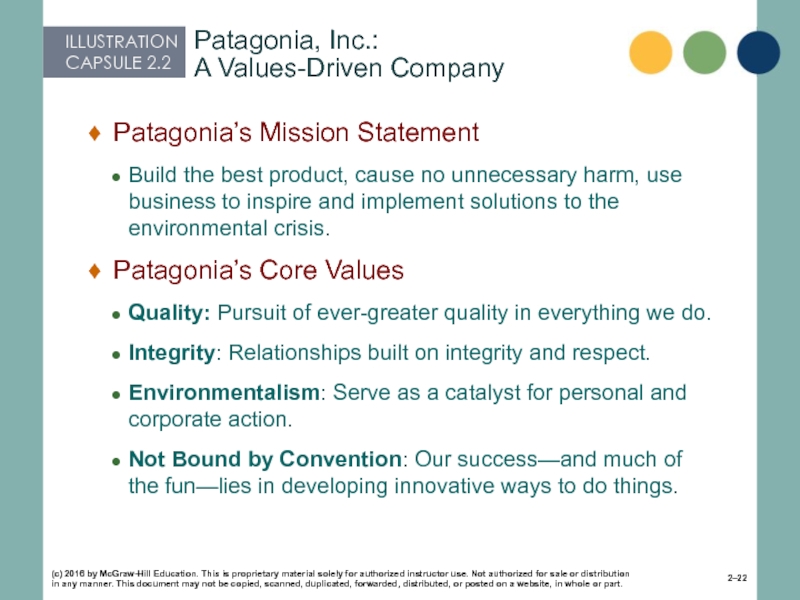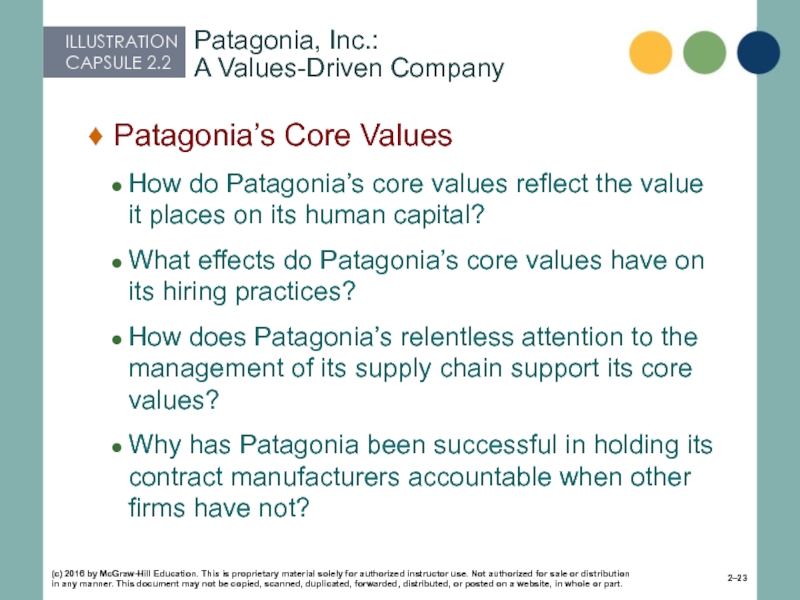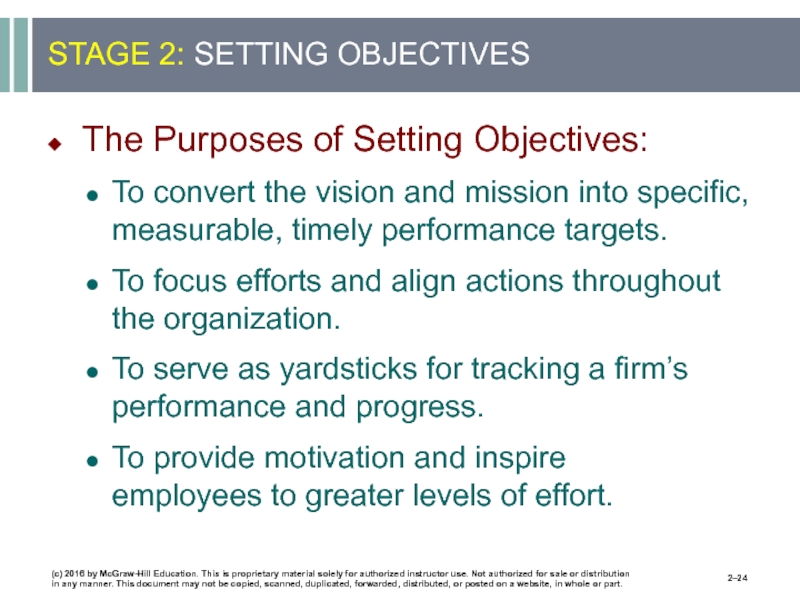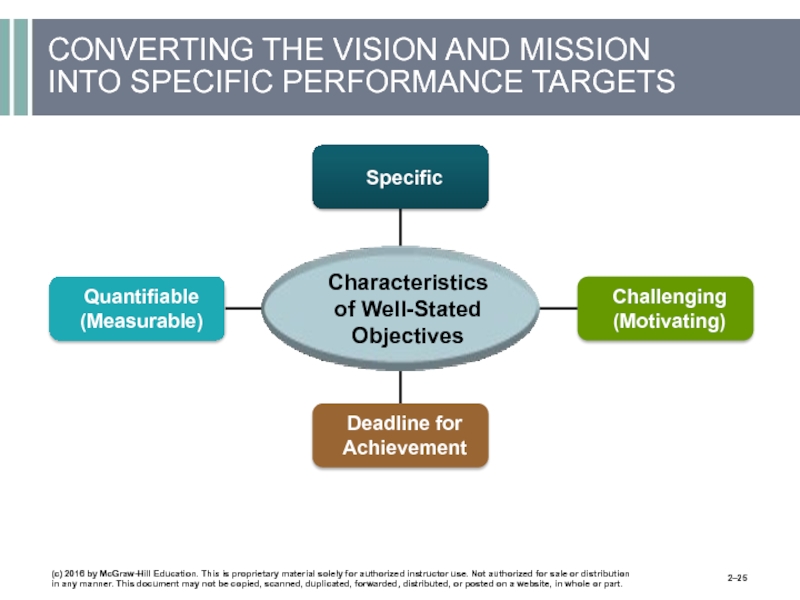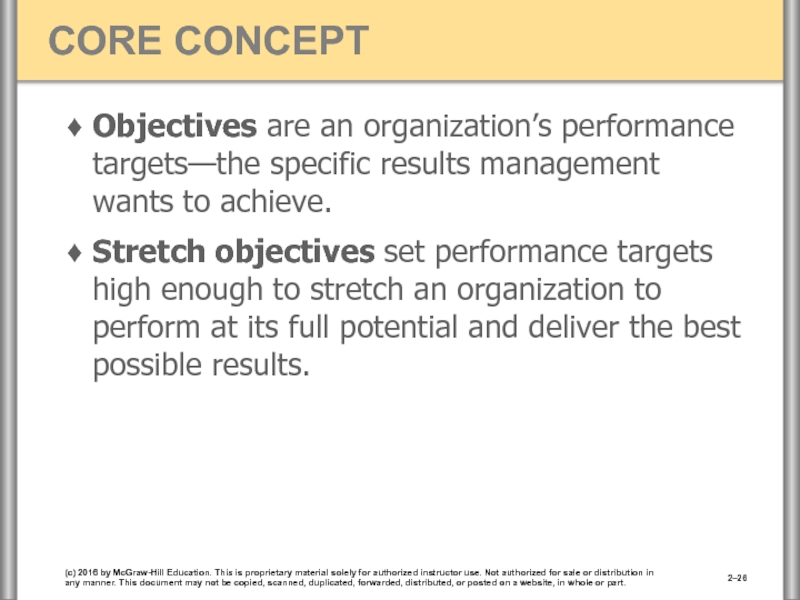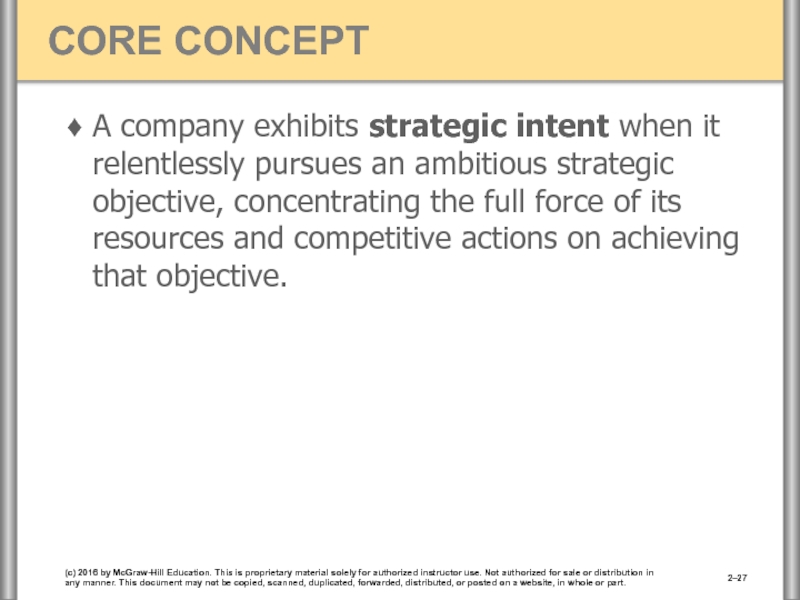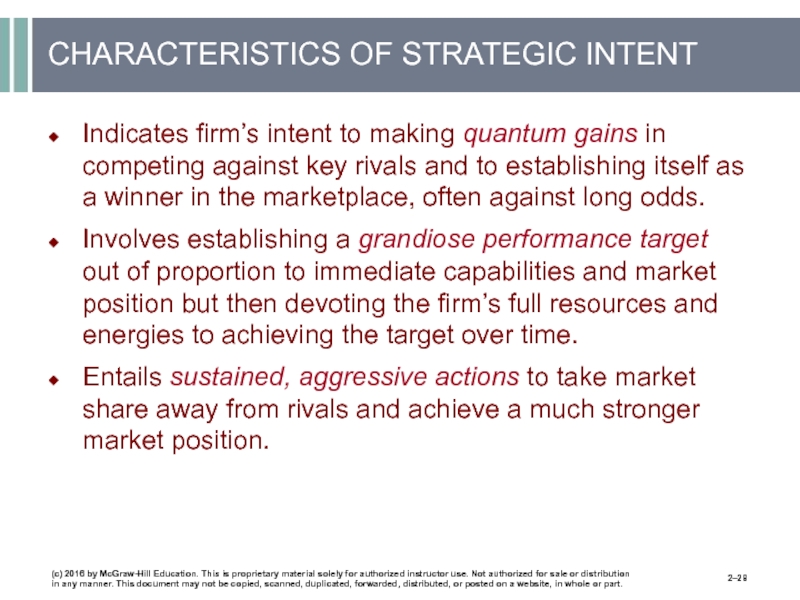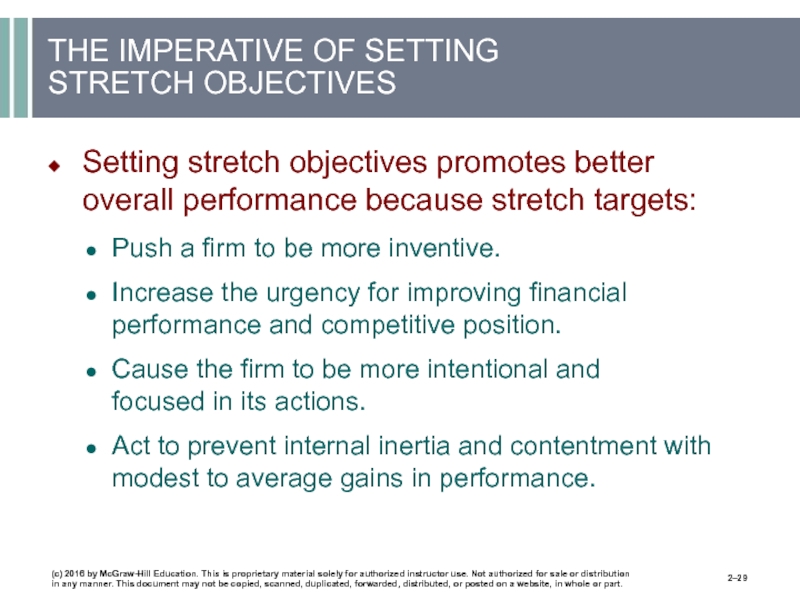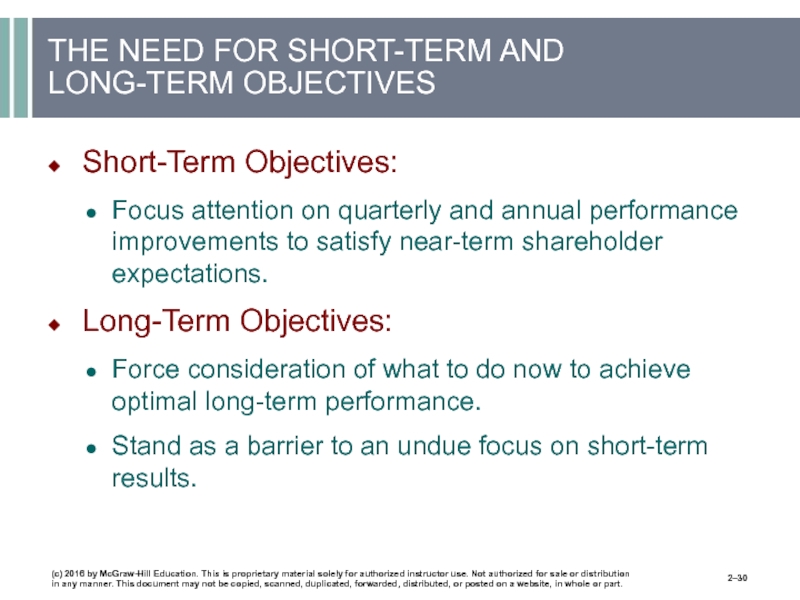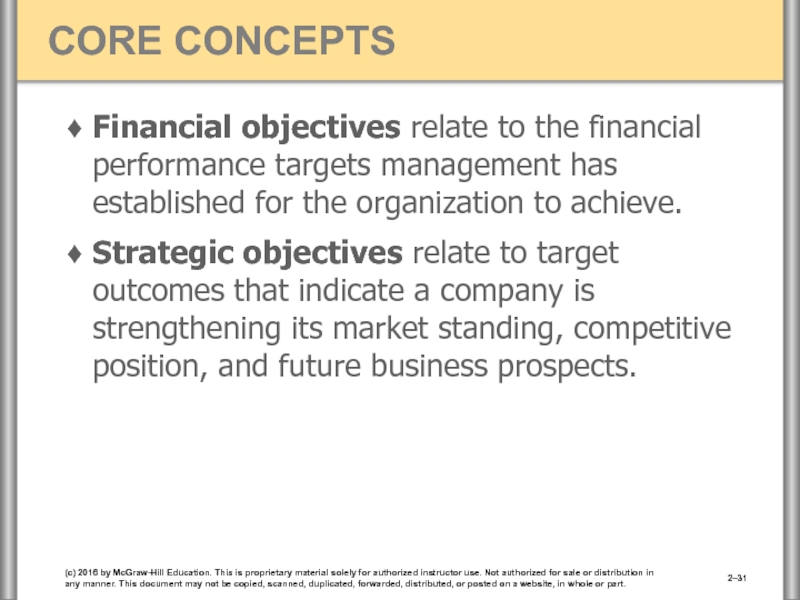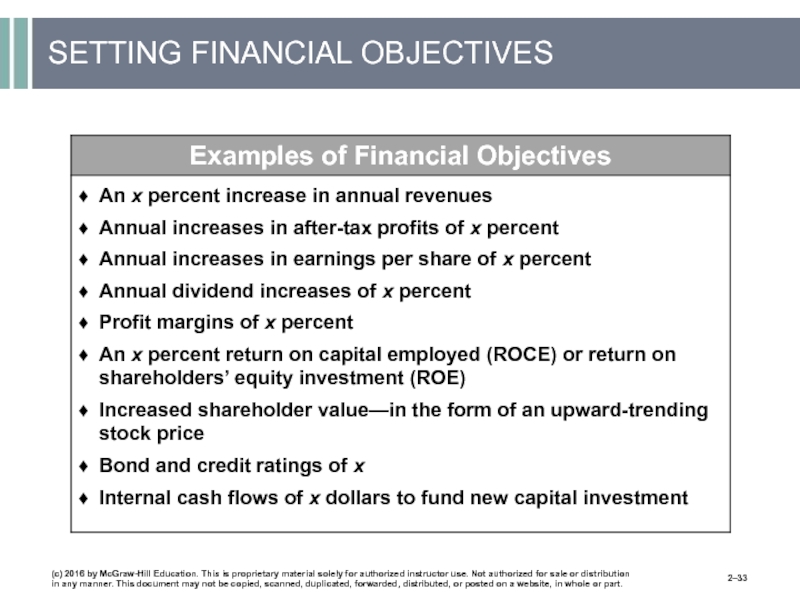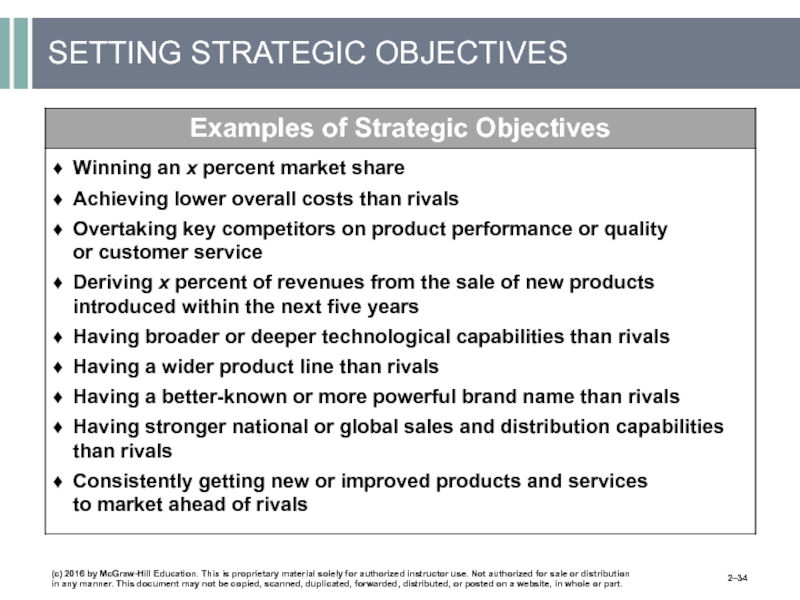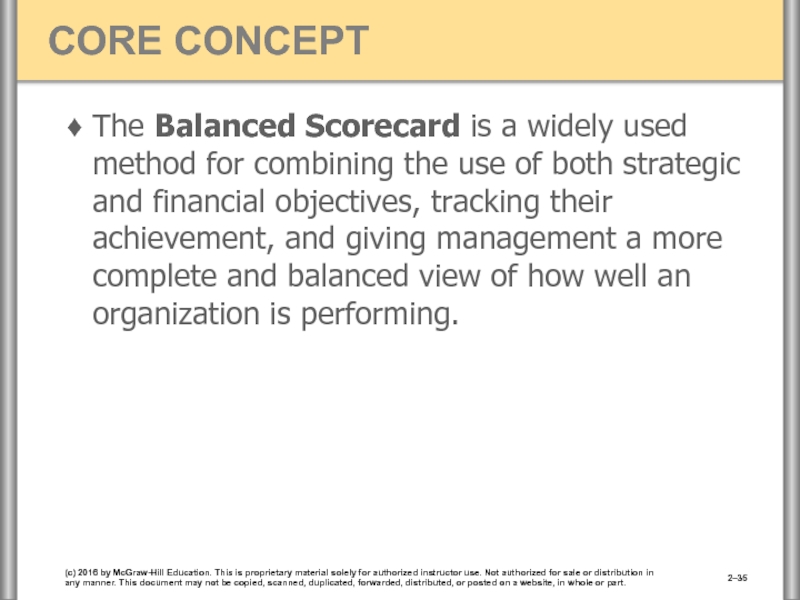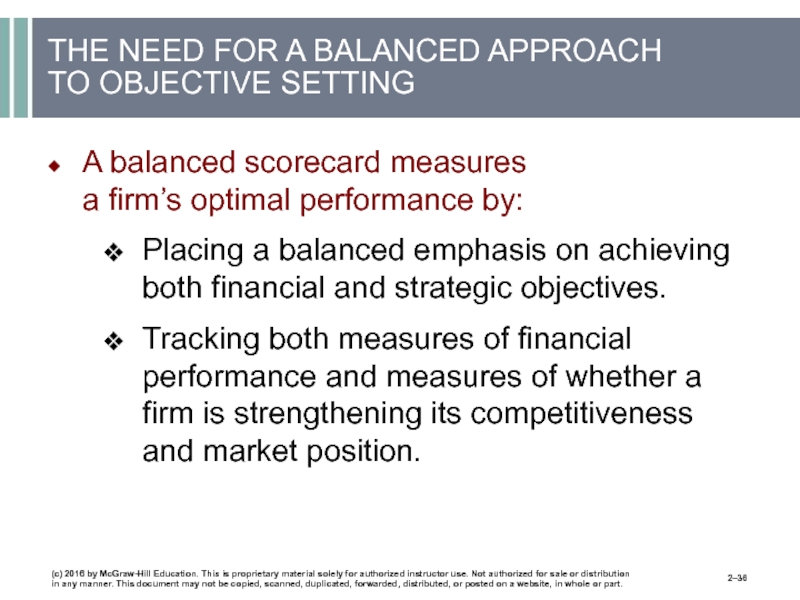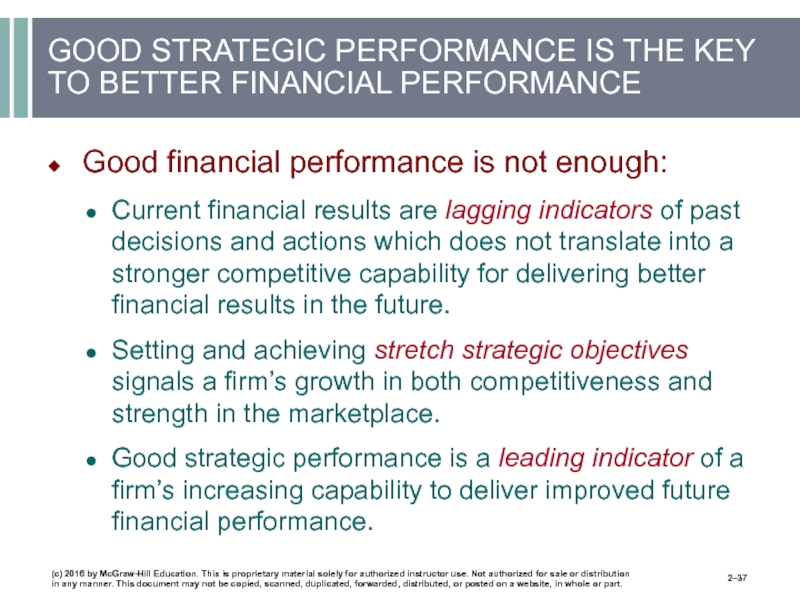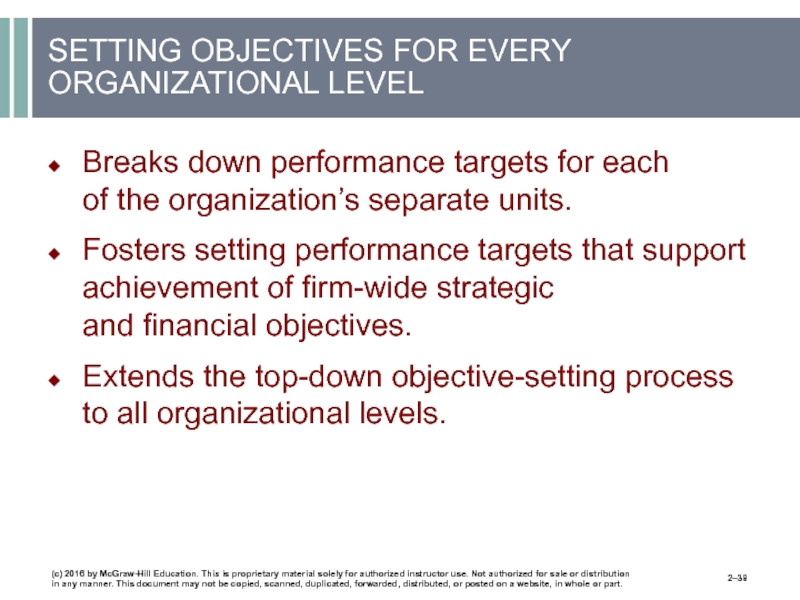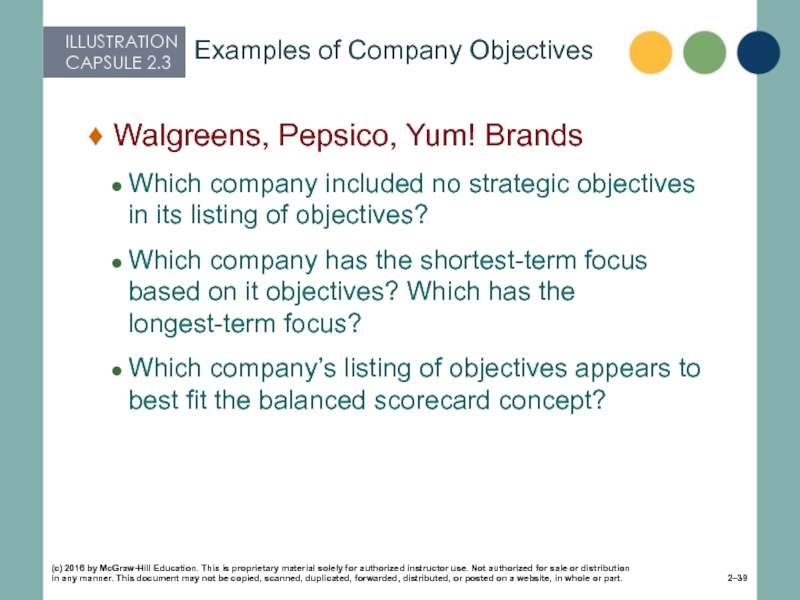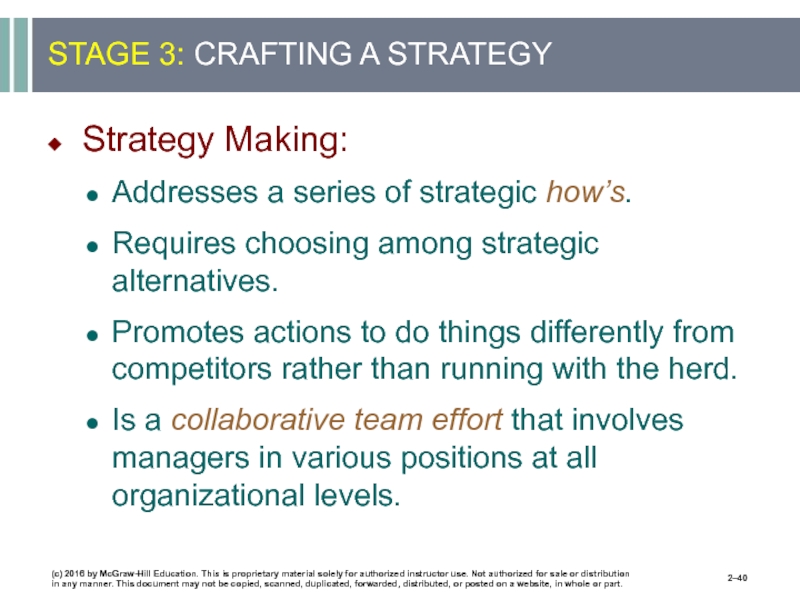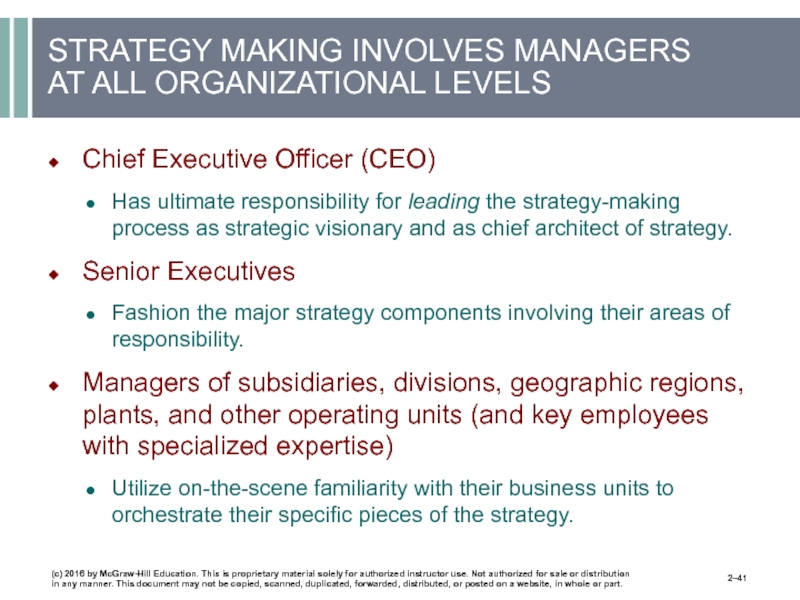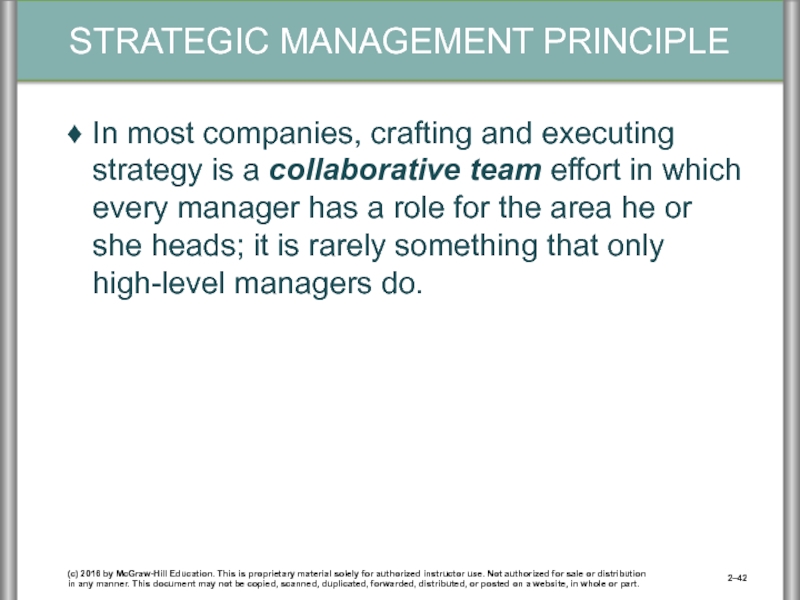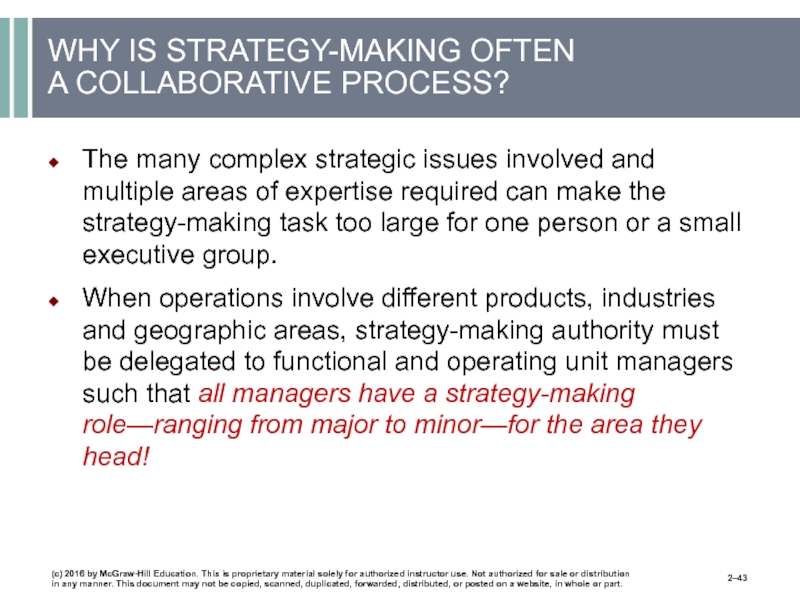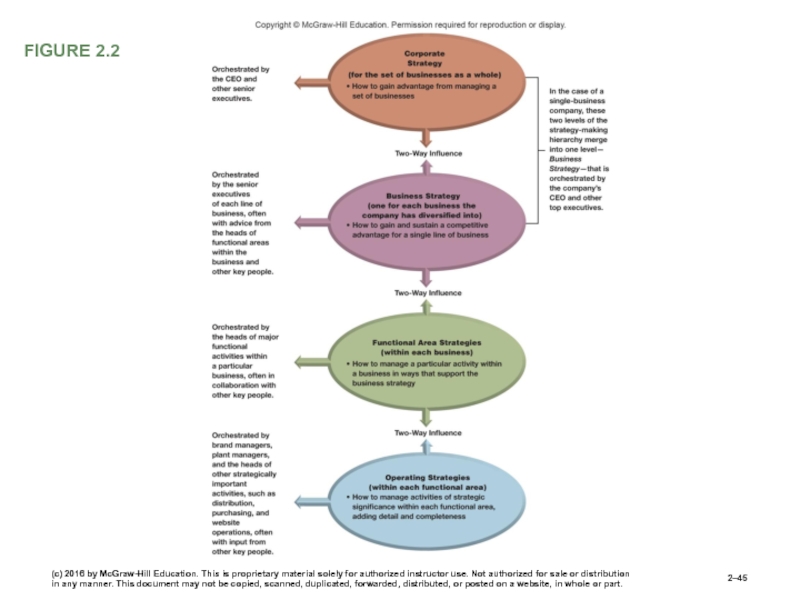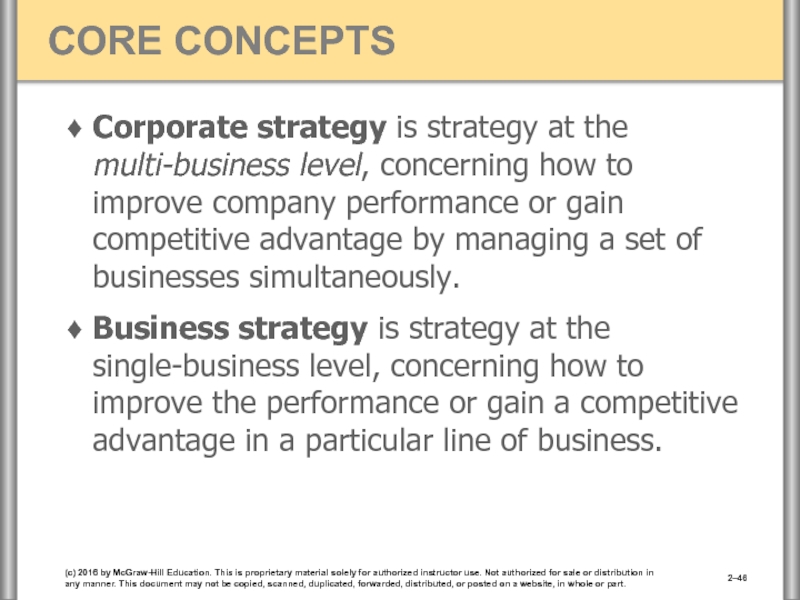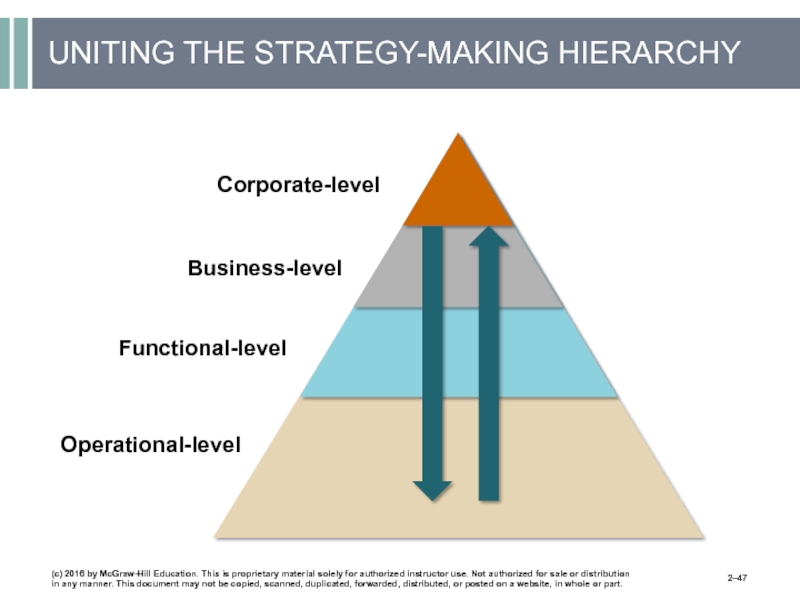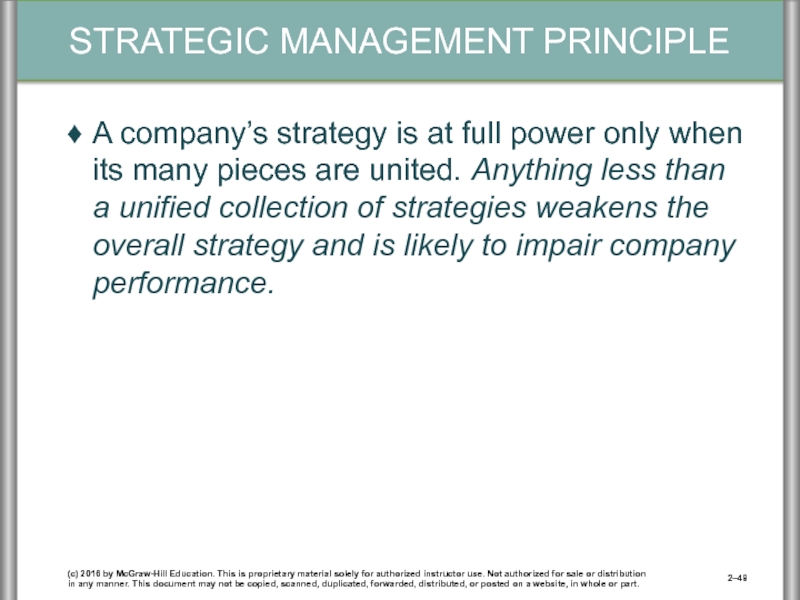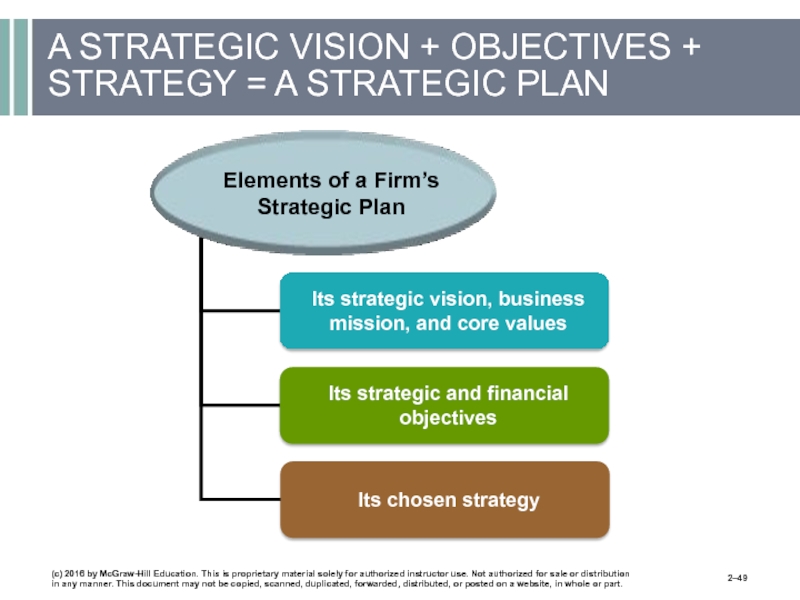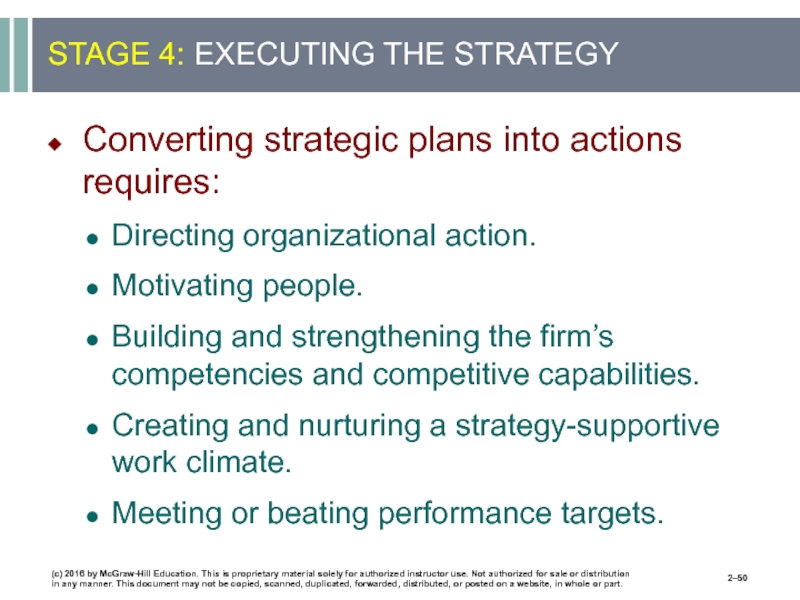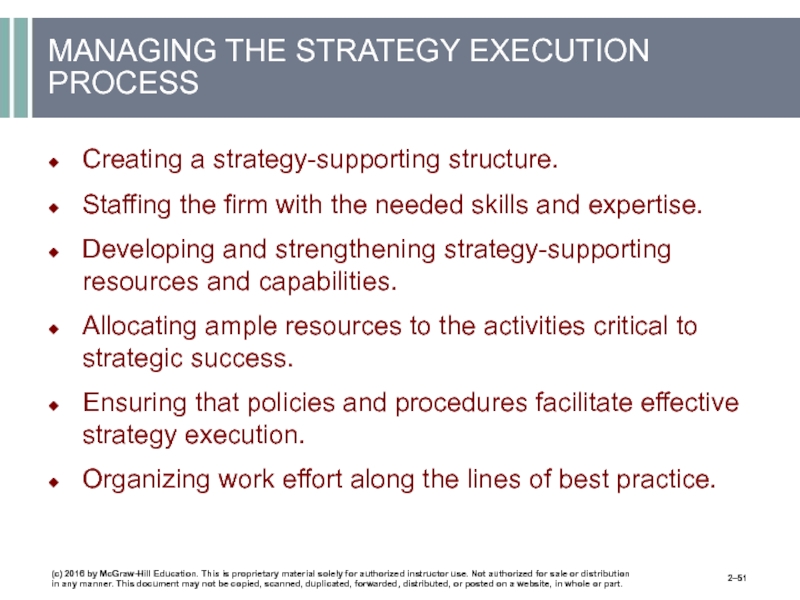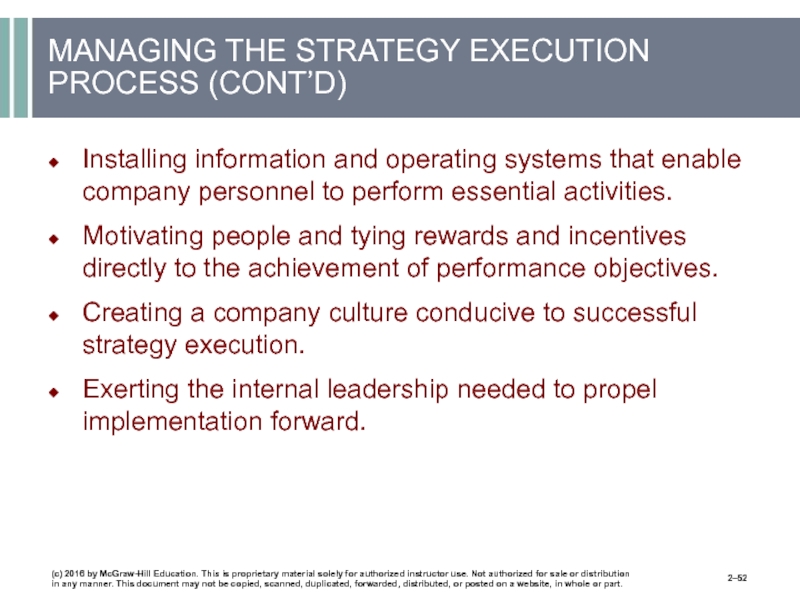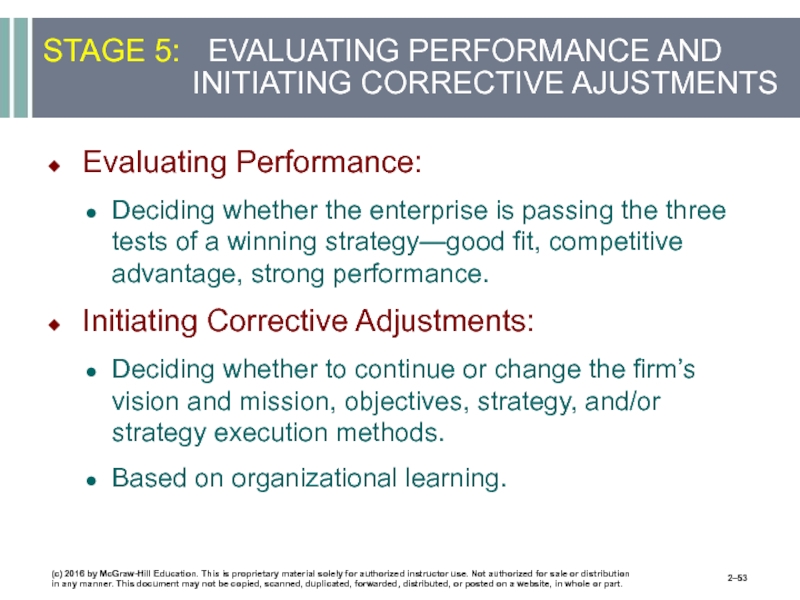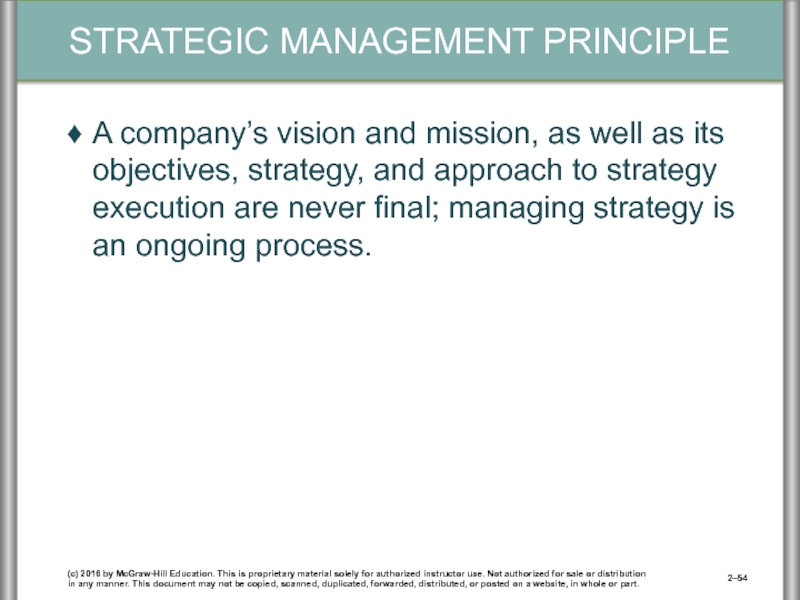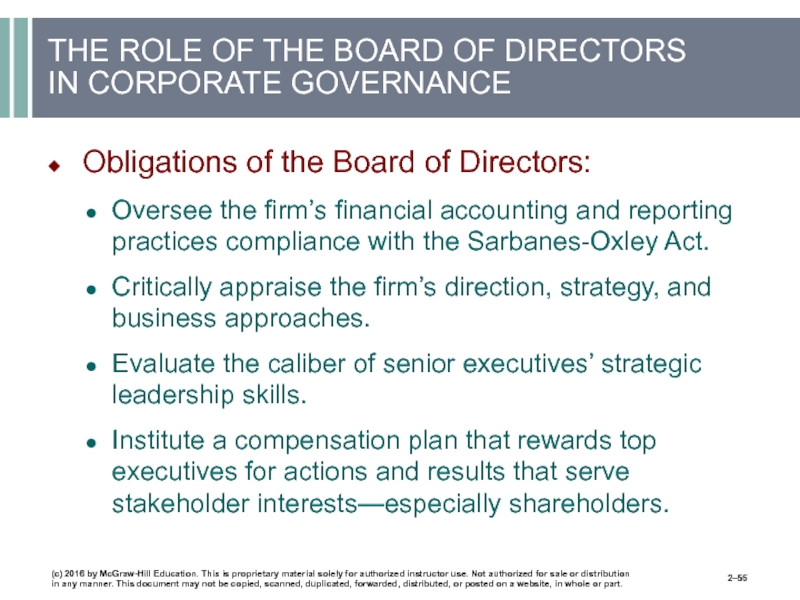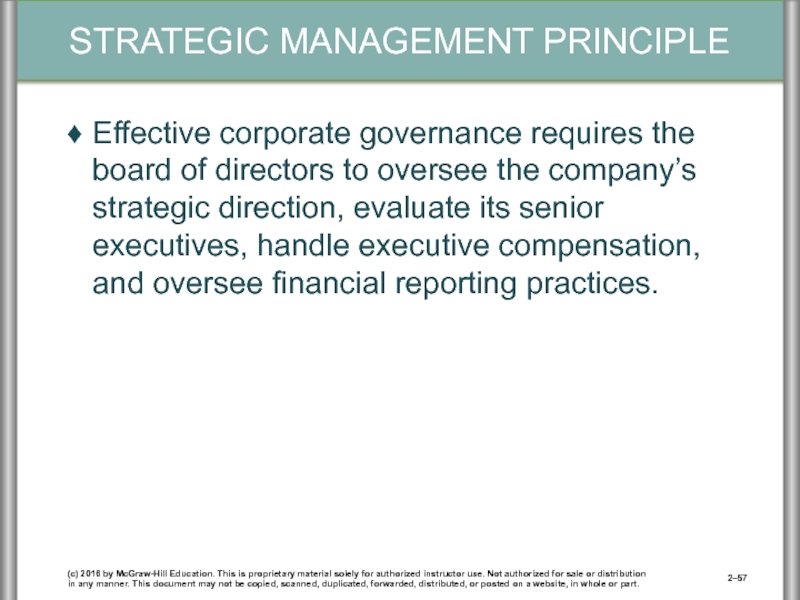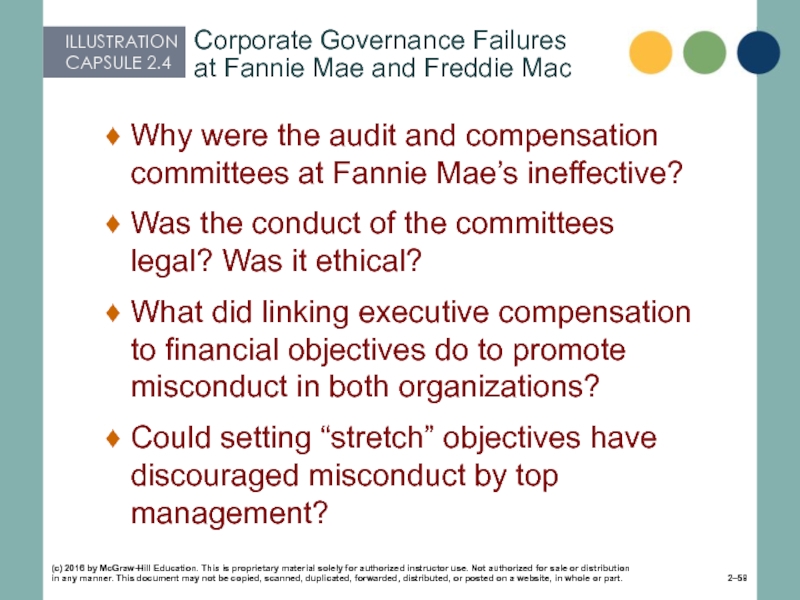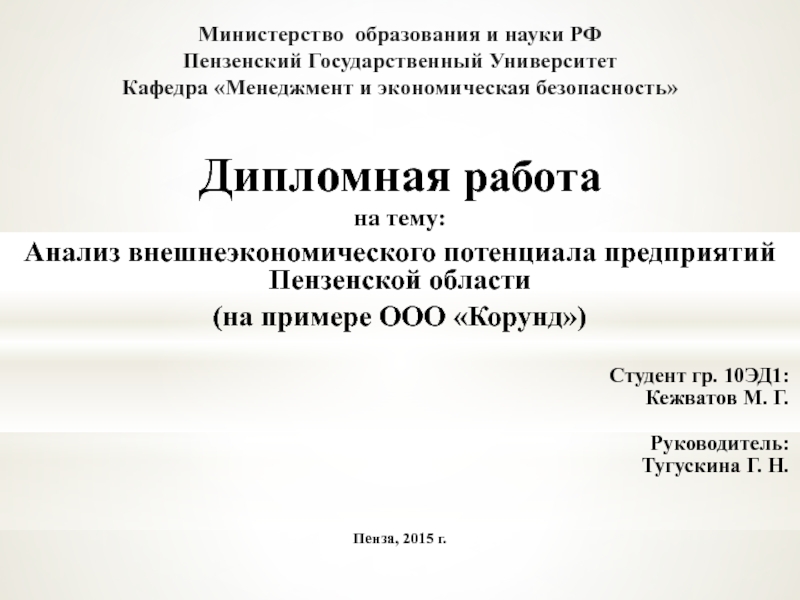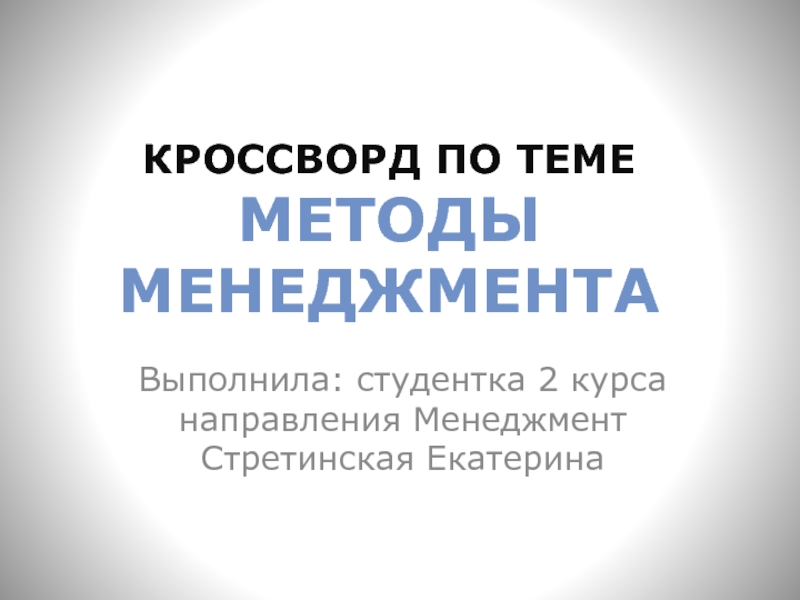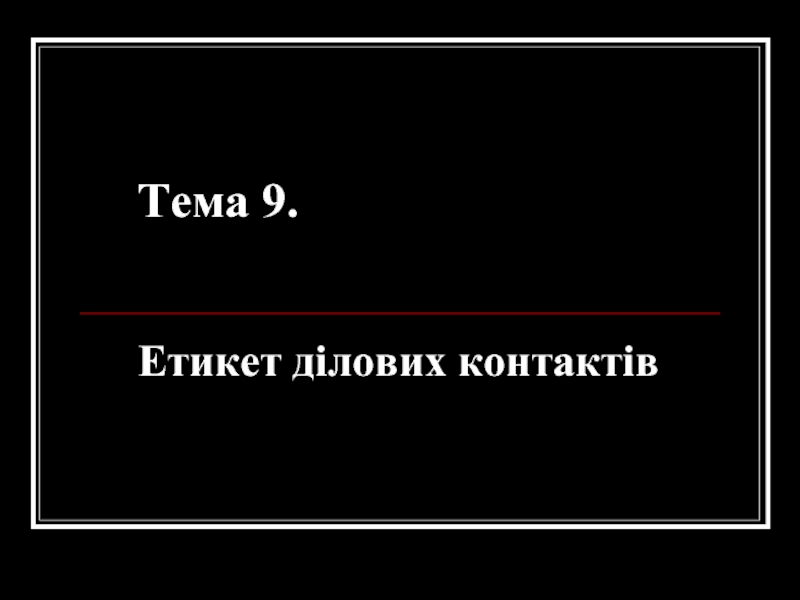- Главная
- Разное
- Дизайн
- Бизнес и предпринимательство
- Аналитика
- Образование
- Развлечения
- Красота и здоровье
- Финансы
- Государство
- Путешествия
- Спорт
- Недвижимость
- Армия
- Графика
- Культурология
- Еда и кулинария
- Лингвистика
- Английский язык
- Астрономия
- Алгебра
- Биология
- География
- Детские презентации
- Информатика
- История
- Литература
- Маркетинг
- Математика
- Медицина
- Менеджмент
- Музыка
- МХК
- Немецкий язык
- ОБЖ
- Обществознание
- Окружающий мир
- Педагогика
- Русский язык
- Технология
- Физика
- Философия
- Химия
- Шаблоны, картинки для презентаций
- Экология
- Экономика
- Юриспруденция
Charting a company’s direction. Its vision, mission, objectives, and strategy. (Chapter 2) презентация
Содержание
- 1. Charting a company’s direction. Its vision, mission, objectives, and strategy. (Chapter 2)
- 2. THIS CHAPTER WILL HELP YOU UNDERSTAND: LO
- 3. WHAT DOES THE STRATEGY-MAKING, STRATEGY-EXECUTING PROCESS
- 4. FIGURE 2.1 The Strategy-Making, Strategy-Executing Process (c)
- 5. A company’s strategic plan lays out its
- 6. STAGE 1: DEVELOPING A STRATEGIC VISION, A
- 7. A strategic vision describes management’s aspirations for
- 8. TABLE 2.1 Wording a Vision Statement—the Dos and Don’ts 2–
- 9. (c) 2016 by McGraw-Hill Education. This is
- 10. (c) 2016 by McGraw-Hill Education. This is
- 11. (c) 2016 by McGraw-Hill Education. This is
- 12. (c) 2016 by McGraw-Hill Education. This is
- 13. COMMUNICATING THE STRATEGIC VISION Why Communicate the
- 14. An effectively communicated vision is a valuable
- 15. PUTTING THE STRATEGIC VISION IN PLACE Put
- 16. WHY A SOUND, WELL-COMMUNICATED STRATEGIC VISION MATTERS
- 17. DEVELOPING A COMPANY MISSION STATEMENT The Mission
- 18. The distinction between a strategic vision and
- 19. THE IDEAL MISSION STATEMENT Identifies the firm’s
- 20. LINKING THE VISION AND MISSION WITH
- 21. A firm’s core values are the beliefs,
- 22. (c) 2016 by McGraw-Hill Education. This is
- 23. (c) 2016 by McGraw-Hill Education. This is
- 24. STAGE 2: SETTING OBJECTIVES The Purposes of
- 25. CONVERTING THE VISION AND MISSION INTO SPECIFIC
- 26. Objectives are an organization’s performance targets—the specific
- 27. A company exhibits strategic intent when it
- 28. CHARACTERISTICS OF STRATEGIC INTENT Indicates firm’s intent
- 29. THE IMPERATIVE OF SETTING STRETCH OBJECTIVES
- 30. THE NEED FOR SHORT-TERM AND LONG-TERM
- 31. Financial objectives relate to the financial performance
- 32. Financial Objectives Communicate top management’s goals for
- 33. SETTING FINANCIAL OBJECTIVES (c) 2016 by McGraw-Hill
- 34. SETTING STRATEGIC OBJECTIVES (c) 2016 by McGraw-Hill
- 35. The Balanced Scorecard is a widely used
- 36. THE NEED FOR A BALANCED APPROACH
- 37. GOOD STRATEGIC PERFORMANCE IS THE KEY
- 38. SETTING OBJECTIVES FOR EVERY ORGANIZATIONAL LEVEL Breaks
- 39. (c) 2016 by McGraw-Hill Education. This is
- 40. STAGE 3: CRAFTING A STRATEGY Strategy Making:
- 41. STRATEGY MAKING INVOLVES MANAGERS AT ALL ORGANIZATIONAL
- 42. In most companies, crafting and executing strategy
- 43. WHY IS STRATEGY-MAKING OFTEN A COLLABORATIVE
- 44. Corporate Strategy Multibusiness Strategy—how to gain synergies
- 45. FIGURE 2.2 (c) 2016 by McGraw-Hill Education.
- 46. Corporate strategy is strategy at the multi-business
- 47. UNITING THE STRATEGY-MAKING HIERARCHY
- 48. A company’s strategy is at full power
- 49. A STRATEGIC VISION + OBJECTIVES + STRATEGY
- 50. STAGE 4: EXECUTING THE STRATEGY Converting strategic
- 51. MANAGING THE STRATEGY EXECUTION PROCESS Creating a
- 52. MANAGING THE STRATEGY EXECUTION PROCESS (CONT’D) Installing
- 53. STAGE 5: EVALUATING PERFORMANCE AND INITIATING CORRECTIVE AJUSTMENTS
- 54. A company’s vision and mission, as well
- 55. THE ROLE OF THE BOARD OF DIRECTORS
- 56. ACHIEVING EFFECTIVE CORPORATE GOVERNANCE A strong,
- 57. Effective corporate governance requires the board of
- 58. (c) 2016 by McGraw-Hill Education. This is
Слайд 1CHAPTER 2
CHARTING A COMPANY’S DIRECTION:
Its Vision, Mission, Objectives, and Strategy
(c)
Слайд 2THIS CHAPTER WILL HELP YOU UNDERSTAND:
LO 1 Why it is critical for
LO 2 The importance of setting both strategic and financial objectives.
LO 3 Why the strategic initiatives taken at various organizational levels must be tightly coordinated to achieve companywide performance targets.
LO 4 What a company must do to achieve operating excellence and to execute its strategy proficiently.
LO 5 The role and responsibility of a company’s board of directors in overseeing the strategic management process.
2–
Слайд 3WHAT DOES THE STRATEGY-MAKING,
STRATEGY-EXECUTING PROCESS ENTAIL?
Developing a strategic vision, a
Setting objectives for measuring the firm's performance and tracking its progress.
Crafting a strategy to move the firm along its strategic course and to achieve its objectives.
Executing the chosen strategy efficiently and effectively.
Monitoring developments, evaluating performance, and initiating corrective adjustments.
(c) 2016 by McGraw-Hill Education. This is proprietary material solely for authorized instructor use. Not authorized for sale or distribution in any manner. This document may not be copied, scanned, duplicated, forwarded, distributed, or posted on a website, in whole or part.
2–
Слайд 4FIGURE 2.1
The Strategy-Making, Strategy-Executing Process
(c) 2016 by McGraw-Hill Education. This is
2–
Слайд 5A company’s strategic plan lays out its future direction, performance targets,
(c) 2016 by McGraw-Hill Education. This is proprietary material solely for authorized instructor use. Not authorized for sale or distribution in any manner. This document may not be copied, scanned, duplicated, forwarded, distributed, or posted on a website, in whole or part.
2–
Слайд 6STAGE 1: DEVELOPING A STRATEGIC VISION, A MISSION STATEMENT, AND A SET OF
Developing a Strategic Vision:
Delineates management’s future aspirations for the firm to its stakeholders.
Provides direction—“where we are going.”
Sets out the compelling rationale
(strategic soundness) for the firm’s direction.
Uses distinctive and specific language to set the firm apart from its rivals.
(c) 2016 by McGraw-Hill Education. This is proprietary material solely for authorized instructor use. Not authorized for sale or distribution in any manner. This document may not be copied, scanned, duplicated, forwarded, distributed, or posted on a website, in whole or part.
2–
Слайд 7A strategic vision describes management’s aspirations for the future and delineates
(c) 2016 by McGraw-Hill Education. This is proprietary material solely for authorized instructor use. Not authorized for sale or distribution in any manner. This document may not be copied, scanned, duplicated, forwarded, distributed, or posted on a website, in whole or part.
2–
Слайд 9(c) 2016 by McGraw-Hill Education. This is proprietary material solely for
2–
Examples of Strategic Visions—How Well Do They Measure Up?
Слайд 10(c) 2016 by McGraw-Hill Education. This is proprietary material solely for
2–
Examples of Strategic Visions—How Well Do They Measure Up?
Слайд 11(c) 2016 by McGraw-Hill Education. This is proprietary material solely for
2–
Examples of Strategic Visions—How Well Do They Measure Up?
Слайд 12(c) 2016 by McGraw-Hill Education. This is proprietary material solely for
2–
For which of these businesses is it the most difficult to create a vision statement?
How does the scope of a business affect the language of its vision statement?
How would you reword the Coca-Cola mission statement to reduce it to less than 100 words?
(Coca-Cola currently = 121 words)
Examples of Strategic Visions—How Well Do They Measure Up?
Слайд 13COMMUNICATING THE STRATEGIC VISION
Why Communicate the Vision:
Fosters employee commitment to the
Ensures understanding of its importance.
Motivates, informs, and inspires internal and external stakeholders.
Demonstrates top management support for the firm’s future strategic direction and competitive efforts.
(c) 2016 by McGraw-Hill Education. This is proprietary material solely for authorized instructor use. Not authorized for sale or distribution in any manner. This document may not be copied, scanned, duplicated, forwarded, distributed, or posted on a website, in whole or part.
2–
Слайд 14An effectively communicated vision is a valuable management tool for enlisting
(c) 2016 by McGraw-Hill Education. This is proprietary material solely for authorized instructor use. Not authorized for sale or distribution in any manner. This document may not be copied, scanned, duplicated, forwarded, distributed, or posted on a website, in whole or part.
2–
Слайд 15PUTTING THE STRATEGIC VISION IN PLACE
Put the vision in writing and
Hold meetings to personally explain the vision and its rationale.
Create a memorable slogan that captures the essence of the vision.
Emphasize the positive payoffs for making the vision happen.
(c) 2016 by McGraw-Hill Education. This is proprietary material solely for authorized instructor use. Not authorized for sale or distribution in any manner. This document may not be copied, scanned, duplicated, forwarded, distributed, or posted on a website, in whole or part.
2–
Слайд 16WHY A SOUND, WELL-COMMUNICATED STRATEGIC VISION MATTERS
It crystallizes senior executives’ own
It reduces the risk of rudderless decision making.
It is a tool for winning the support of organization members to help make the vision a reality
It provides a beacon for lower-level managers in setting departmental objectives and crafting departmental strategies that are in sync with the firm’s overall strategy.
It helps an organization prepare for the future.
(c) 2016 by McGraw-Hill Education. This is proprietary material solely for authorized instructor use. Not authorized for sale or distribution in any manner. This document may not be copied, scanned, duplicated, forwarded, distributed, or posted on a website, in whole or part.
2–
Слайд 17DEVELOPING A COMPANY MISSION STATEMENT
The Mission Statement:
Uses specific language to give
Describes the firm’s current business and purpose—“who we are, what we do, and why we are here.”
Should focus on describing the firm’s business, not on “making a profit”—earning a profit is an objective not a mission.
(c) 2016 by McGraw-Hill Education. This is proprietary material solely for authorized instructor use. Not authorized for sale or distribution in any manner. This document may not be copied, scanned, duplicated, forwarded, distributed, or posted on a website, in whole or part.
2–
Слайд 18The distinction between a strategic vision and a mission statement is
A strategic vision portrays a firm’s aspirations for its future (“where we are going”)
A firm’s mission describes its purpose and its present business (“who we are, what we do, and why we are here”).
(c) 2016 by McGraw-Hill Education. This is proprietary material solely for authorized instructor use. Not authorized for sale or distribution in any manner. This document may not be copied, scanned, duplicated, forwarded, distributed, or posted on a website, in whole or part.
2–
Слайд 19THE IDEAL MISSION STATEMENT
Identifies the firm’s product or services.
Specifies the buyer
Identifies the customer groups or markets it is endeavoring to serve.
Specifies its approach to pleasing customers.
Sets the firm apart from its rivals.
Clarifies the firm’s business to stakeholders.
(c) 2016 by McGraw-Hill Education. This is proprietary material solely for authorized instructor use. Not authorized for sale or distribution in any manner. This document may not be copied, scanned, duplicated, forwarded, distributed, or posted on a website, in whole or part.
2–
Слайд 20LINKING THE VISION AND MISSION
WITH CORE VALUES
Core Values
Are the beliefs,
Become an integral part of the firm’s culture and what makes it tick when strongly espoused and supported by top management.
Matched with the firm’s vision, mission, and strategy contribute to the firm’s business success.
(c) 2016 by McGraw-Hill Education. This is proprietary material solely for authorized instructor use. Not authorized for sale or distribution in any manner. This document may not be copied, scanned, duplicated, forwarded, distributed, or posted on a website, in whole or part.
2–
Слайд 21A firm’s core values are the beliefs, traits, and behavioral norms
(c) 2016 by McGraw-Hill Education. This is proprietary material solely for authorized instructor use. Not authorized for sale or distribution in any manner. This document may not be copied, scanned, duplicated, forwarded, distributed, or posted on a website, in whole or part.
2–
Слайд 22(c) 2016 by McGraw-Hill Education. This is proprietary material solely for
2–
Patagonia’s Mission Statement
Build the best product, cause no unnecessary harm, use business to inspire and implement solutions to the environmental crisis.
Patagonia’s Core Values
Quality: Pursuit of ever-greater quality in everything we do.
Integrity: Relationships built on integrity and respect.
Environmentalism: Serve as a catalyst for personal and corporate action.
Not Bound by Convention: Our success—and much of the fun—lies in developing innovative ways to do things.
Patagonia, Inc.:
A Values-Driven Company
Слайд 23(c) 2016 by McGraw-Hill Education. This is proprietary material solely for
2–
Patagonia’s Core Values
How do Patagonia’s core values reflect the value it places on its human capital?
What effects do Patagonia’s core values have on its hiring practices?
How does Patagonia’s relentless attention to the management of its supply chain support its core values?
Why has Patagonia been successful in holding its contract manufacturers accountable when other firms have not?
Patagonia, Inc.:
A Values-Driven Company
Слайд 24STAGE 2: SETTING OBJECTIVES
The Purposes of Setting Objectives:
To convert the vision
To focus efforts and align actions throughout the organization.
To serve as yardsticks for tracking a firm’s performance and progress.
To provide motivation and inspire employees to greater levels of effort.
(c) 2016 by McGraw-Hill Education. This is proprietary material solely for authorized instructor use. Not authorized for sale or distribution in any manner. This document may not be copied, scanned, duplicated, forwarded, distributed, or posted on a website, in whole or part.
2–
Слайд 25CONVERTING THE VISION AND MISSION
INTO SPECIFIC PERFORMANCE TARGETS
(c) 2016 by McGraw-Hill
2–
Quantifiable
(Measurable)
Challenging
(Motivating)
Deadline for
Achievement
Characteristics of Well-Stated Objectives
Specific
Слайд 26Objectives are an organization’s performance targets—the specific results management wants to
Stretch objectives set performance targets high enough to stretch an organization to perform at its full potential and deliver the best possible results.
(c) 2016 by McGraw-Hill Education. This is proprietary material solely for authorized instructor use. Not authorized for sale or distribution in any manner. This document may not be copied, scanned, duplicated, forwarded, distributed, or posted on a website, in whole or part.
2–
Слайд 27A company exhibits strategic intent when it relentlessly pursues an ambitious
(c) 2016 by McGraw-Hill Education. This is proprietary material solely for authorized instructor use. Not authorized for sale or distribution in any manner. This document may not be copied, scanned, duplicated, forwarded, distributed, or posted on a website, in whole or part.
2–
Слайд 28CHARACTERISTICS OF STRATEGIC INTENT
Indicates firm’s intent to making quantum gains in
Involves establishing a grandiose performance target out of proportion to immediate capabilities and market position but then devoting the firm’s full resources and energies to achieving the target over time.
Entails sustained, aggressive actions to take market share away from rivals and achieve a much stronger market position.
(c) 2016 by McGraw-Hill Education. This is proprietary material solely for authorized instructor use. Not authorized for sale or distribution in any manner. This document may not be copied, scanned, duplicated, forwarded, distributed, or posted on a website, in whole or part.
2–
Слайд 29THE IMPERATIVE OF SETTING
STRETCH OBJECTIVES
Setting stretch objectives promotes better overall
Push a firm to be more inventive.
Increase the urgency for improving financial performance and competitive position.
Cause the firm to be more intentional and focused in its actions.
Act to prevent internal inertia and contentment with modest to average gains in performance.
(c) 2016 by McGraw-Hill Education. This is proprietary material solely for authorized instructor use. Not authorized for sale or distribution in any manner. This document may not be copied, scanned, duplicated, forwarded, distributed, or posted on a website, in whole or part.
2–
Слайд 30THE NEED FOR SHORT-TERM AND
LONG-TERM OBJECTIVES
Short-Term Objectives:
Focus attention on quarterly
Long-Term Objectives:
Force consideration of what to do now to achieve optimal long-term performance.
Stand as a barrier to an undue focus on short-term results.
(c) 2016 by McGraw-Hill Education. This is proprietary material solely for authorized instructor use. Not authorized for sale or distribution in any manner. This document may not be copied, scanned, duplicated, forwarded, distributed, or posted on a website, in whole or part.
2–
Слайд 31Financial objectives relate to the financial performance targets management has established
Strategic objectives relate to target outcomes that indicate a company is strengthening its market standing, competitive position, and future business prospects.
(c) 2016 by McGraw-Hill Education. This is proprietary material solely for authorized instructor use. Not authorized for sale or distribution in any manner. This document may not be copied, scanned, duplicated, forwarded, distributed, or posted on a website, in whole or part.
2–
Слайд 32Financial Objectives
Communicate top management’s goals for financial performance.
Are focused internally on
Strategic Objectives
Are the firm's goals related to marketing standing and competitive position.
Are focused externally on competition vis-à-vis the firm’s rivals.
WHAT KINDS OF OBJECTIVES TO SET
(c) 2016 by McGraw-Hill Education. This is proprietary material solely for authorized instructor use. Not authorized for sale or distribution in any manner. This document may not be copied, scanned, duplicated, forwarded, distributed, or posted on a website, in whole or part.
2–
Слайд 33SETTING FINANCIAL OBJECTIVES
(c) 2016 by McGraw-Hill Education. This is proprietary material
2–
Слайд 34SETTING STRATEGIC OBJECTIVES
(c) 2016 by McGraw-Hill Education. This is proprietary material
2–
Слайд 35The Balanced Scorecard is a widely used method for combining the
(c) 2016 by McGraw-Hill Education. This is proprietary material solely for authorized instructor use. Not authorized for sale or distribution in any manner. This document may not be copied, scanned, duplicated, forwarded, distributed, or posted on a website, in whole or part.
2–
Слайд 36THE NEED FOR A BALANCED APPROACH
TO OBJECTIVE SETTING
A balanced scorecard
Placing a balanced emphasis on achieving both financial and strategic objectives.
Tracking both measures of financial performance and measures of whether a firm is strengthening its competitiveness and market position.
(c) 2016 by McGraw-Hill Education. This is proprietary material solely for authorized instructor use. Not authorized for sale or distribution in any manner. This document may not be copied, scanned, duplicated, forwarded, distributed, or posted on a website, in whole or part.
2–
Слайд 37GOOD STRATEGIC PERFORMANCE IS THE KEY
TO BETTER FINANCIAL PERFORMANCE
Good financial
Current financial results are lagging indicators of past decisions and actions which does not translate into a stronger competitive capability for delivering better financial results in the future.
Setting and achieving stretch strategic objectives signals a firm’s growth in both competitiveness and strength in the marketplace.
Good strategic performance is a leading indicator of a firm’s increasing capability to deliver improved future financial performance.
(c) 2016 by McGraw-Hill Education. This is proprietary material solely for authorized instructor use. Not authorized for sale or distribution in any manner. This document may not be copied, scanned, duplicated, forwarded, distributed, or posted on a website, in whole or part.
2–
Слайд 38SETTING OBJECTIVES FOR EVERY ORGANIZATIONAL LEVEL
Breaks down performance targets for each
Fosters setting performance targets that support achievement of firm-wide strategic and financial objectives.
Extends the top-down objective-setting process to all organizational levels.
(c) 2016 by McGraw-Hill Education. This is proprietary material solely for authorized instructor use. Not authorized for sale or distribution in any manner. This document may not be copied, scanned, duplicated, forwarded, distributed, or posted on a website, in whole or part.
2–
Слайд 39(c) 2016 by McGraw-Hill Education. This is proprietary material solely for
2–
Walgreens, Pepsico, Yum! Brands
Which company included no strategic objectives in its listing of objectives?
Which company has the shortest-term focus based on it objectives? Which has the longest-term focus?
Which company’s listing of objectives appears to best fit the balanced scorecard concept?
Examples of Company Objectives
Слайд 40STAGE 3: CRAFTING A STRATEGY
Strategy Making:
Addresses a series of strategic how’s.
Requires
Promotes actions to do things differently from competitors rather than running with the herd.
Is a collaborative team effort that involves managers in various positions at all organizational levels.
(c) 2016 by McGraw-Hill Education. This is proprietary material solely for authorized instructor use. Not authorized for sale or distribution in any manner. This document may not be copied, scanned, duplicated, forwarded, distributed, or posted on a website, in whole or part.
2–
Слайд 41STRATEGY MAKING INVOLVES MANAGERS
AT ALL ORGANIZATIONAL LEVELS
Chief Executive Officer (CEO)
Has ultimate
Senior Executives
Fashion the major strategy components involving their areas of responsibility.
Managers of subsidiaries, divisions, geographic regions, plants, and other operating units (and key employees with specialized expertise)
Utilize on-the-scene familiarity with their business units to orchestrate their specific pieces of the strategy.
(c) 2016 by McGraw-Hill Education. This is proprietary material solely for authorized instructor use. Not authorized for sale or distribution in any manner. This document may not be copied, scanned, duplicated, forwarded, distributed, or posted on a website, in whole or part.
2–
Слайд 42In most companies, crafting and executing strategy is a collaborative team
(c) 2016 by McGraw-Hill Education. This is proprietary material solely for authorized instructor use. Not authorized for sale or distribution in any manner. This document may not be copied, scanned, duplicated, forwarded, distributed, or posted on a website, in whole or part.
2–
Слайд 43WHY IS STRATEGY-MAKING OFTEN
A COLLABORATIVE PROCESS?
The many complex strategic issues
When operations involve different products, industries and geographic areas, strategy-making authority must be delegated to functional and operating unit managers such that all managers have a strategy-making role—ranging from major to minor—for the area they head!
(c) 2016 by McGraw-Hill Education. This is proprietary material solely for authorized instructor use. Not authorized for sale or distribution in any manner. This document may not be copied, scanned, duplicated, forwarded, distributed, or posted on a website, in whole or part.
2–
Слайд 44Corporate
Strategy
Multibusiness Strategy—how to gain synergies from managing a portfolio of businesses
Business
Strategy
How to strengthen market position and gain competitive advantage
Actions to build competitive capabilities of single businesses
Monitoring and aligning lower-level strategies
Functional Area Strategies
• Add relevant detail to the how’s of the business strategy
• Provide a game plan for managing a particular activity in ways that support the business strategy
Operating
Strategies
• Add detail and completeness to business and functional strategies
• Provide a game plan for managing specific operating activities with strategic significance
A FIRM’S STRATEGY-MAKING HIERARCHY
(c) 2016 by McGraw-Hill Education. This is proprietary material solely for authorized instructor use. Not authorized for sale or distribution in any manner. This document may not be copied, scanned, duplicated, forwarded, distributed, or posted on a website, in whole or part.
2–
Слайд 45FIGURE 2.2
(c) 2016 by McGraw-Hill Education. This is proprietary material solely
2–
Слайд 46Corporate strategy is strategy at the multi-business level, concerning how to
Business strategy is strategy at the single-business level, concerning how to improve the performance or gain a competitive advantage in a particular line of business.
(c) 2016 by McGraw-Hill Education. This is proprietary material solely for authorized instructor use. Not authorized for sale or distribution in any manner. This document may not be copied, scanned, duplicated, forwarded, distributed, or posted on a website, in whole or part.
2–
Слайд 47UNITING THE STRATEGY-MAKING HIERARCHY
Business-level
Corporate-level
Functional-level
Operational-level
(c) 2016 by McGraw-Hill Education. This is proprietary
2–
Слайд 48A company’s strategy is at full power only when its many
(c) 2016 by McGraw-Hill Education. This is proprietary material solely for authorized instructor use. Not authorized for sale or distribution in any manner. This document may not be copied, scanned, duplicated, forwarded, distributed, or posted on a website, in whole or part.
2–
Слайд 49A STRATEGIC VISION + OBJECTIVES + STRATEGY = A STRATEGIC PLAN
Its
Its strategic and financial objectives
Its chosen strategy
Elements of a Firm’s Strategic Plan
(c) 2016 by McGraw-Hill Education. This is proprietary material solely for authorized instructor use. Not authorized for sale or distribution in any manner. This document may not be copied, scanned, duplicated, forwarded, distributed, or posted on a website, in whole or part.
2–
Слайд 50STAGE 4: EXECUTING THE STRATEGY
Converting strategic plans into actions requires:
Directing organizational
Motivating people.
Building and strengthening the firm’s competencies and competitive capabilities.
Creating and nurturing a strategy-supportive work climate.
Meeting or beating performance targets.
(c) 2016 by McGraw-Hill Education. This is proprietary material solely for authorized instructor use. Not authorized for sale or distribution in any manner. This document may not be copied, scanned, duplicated, forwarded, distributed, or posted on a website, in whole or part.
2–
Слайд 51MANAGING THE STRATEGY EXECUTION PROCESS
Creating a strategy-supporting structure.
Staffing the firm with
Developing and strengthening strategy-supporting resources and capabilities.
Allocating ample resources to the activities critical to strategic success.
Ensuring that policies and procedures facilitate effective strategy execution.
Organizing work effort along the lines of best practice.
(c) 2016 by McGraw-Hill Education. This is proprietary material solely for authorized instructor use. Not authorized for sale or distribution in any manner. This document may not be copied, scanned, duplicated, forwarded, distributed, or posted on a website, in whole or part.
2–
Слайд 52MANAGING THE STRATEGY EXECUTION PROCESS (CONT’D)
Installing information and operating systems that
Motivating people and tying rewards and incentives directly to the achievement of performance objectives.
Creating a company culture conducive to successful strategy execution.
Exerting the internal leadership needed to propel implementation forward.
(c) 2016 by McGraw-Hill Education. This is proprietary material solely for authorized instructor use. Not authorized for sale or distribution in any manner. This document may not be copied, scanned, duplicated, forwarded, distributed, or posted on a website, in whole or part.
2–
Слайд 53STAGE 5: EVALUATING PERFORMANCE AND INITIATING CORRECTIVE AJUSTMENTS
Evaluating Performance:
Deciding whether the enterprise
Initiating Corrective Adjustments:
Deciding whether to continue or change the firm’s vision and mission, objectives, strategy, and/or strategy execution methods.
Based on organizational learning.
(c) 2016 by McGraw-Hill Education. This is proprietary material solely for authorized instructor use. Not authorized for sale or distribution in any manner. This document may not be copied, scanned, duplicated, forwarded, distributed, or posted on a website, in whole or part.
2–
Слайд 54A company’s vision and mission, as well as its objectives, strategy,
(c) 2016 by McGraw-Hill Education. This is proprietary material solely for authorized instructor use. Not authorized for sale or distribution in any manner. This document may not be copied, scanned, duplicated, forwarded, distributed, or posted on a website, in whole or part.
2–
Слайд 55THE ROLE OF THE BOARD OF DIRECTORS
IN CORPORATE GOVERNANCE
Obligations of
Oversee the firm’s financial accounting and reporting practices compliance with the Sarbanes-Oxley Act.
Critically appraise the firm’s direction, strategy, and business approaches.
Evaluate the caliber of senior executives’ strategic leadership skills.
Institute a compensation plan that rewards top executives for actions and results that serve stakeholder interests—especially shareholders.
(c) 2016 by McGraw-Hill Education. This is proprietary material solely for authorized instructor use. Not authorized for sale or distribution in any manner. This document may not be copied, scanned, duplicated, forwarded, distributed, or posted on a website, in whole or part.
2–
Слайд 56ACHIEVING EFFECTIVE
CORPORATE GOVERNANCE
A strong, independent board of directors:
Is well informed
Guides and judges the CEO and other executives.
Can curb management actions the board believes are inappropriate or unduly risky.
Can certify to shareholders that the CEO is doing what the board expects.
Provides insight and advice to top management.
Is actively involved in debating the pros and cons of key strategic decisions and actions.
(c) 2016 by McGraw-Hill Education. This is proprietary material solely for authorized instructor use. Not authorized for sale or distribution in any manner. This document may not be copied, scanned, duplicated, forwarded, distributed, or posted on a website, in whole or part.
2–
Слайд 57Effective corporate governance requires the board of directors to oversee the
(c) 2016 by McGraw-Hill Education. This is proprietary material solely for authorized instructor use. Not authorized for sale or distribution in any manner. This document may not be copied, scanned, duplicated, forwarded, distributed, or posted on a website, in whole or part.
2–
Слайд 58(c) 2016 by McGraw-Hill Education. This is proprietary material solely for
2–
Why were the audit and compensation committees at Fannie Mae’s ineffective?
Was the conduct of the committees legal? Was it ethical?
What did linking executive compensation to financial objectives do to promote misconduct in both organizations?
Could setting “stretch” objectives have discouraged misconduct by top management?
Corporate Governance Failures at Fannie Mae and Freddie Mac
